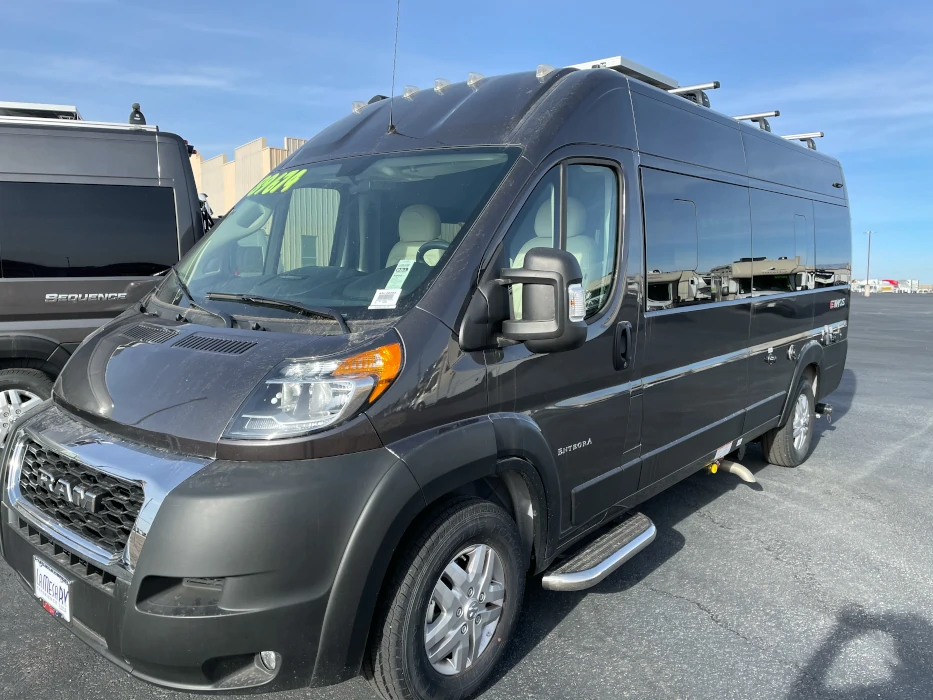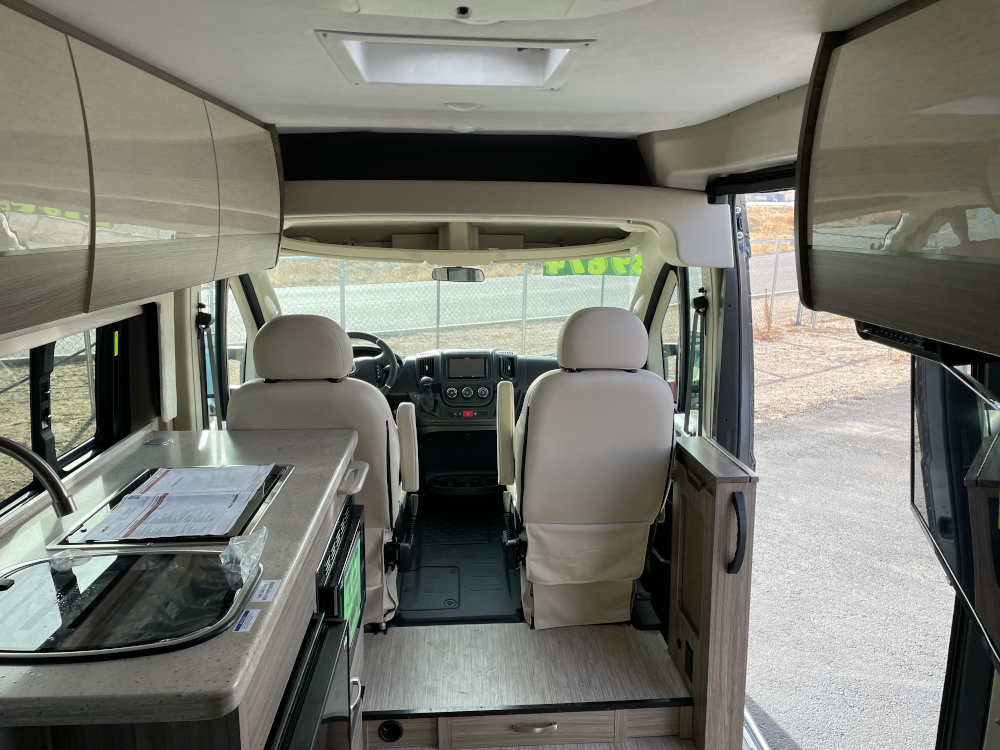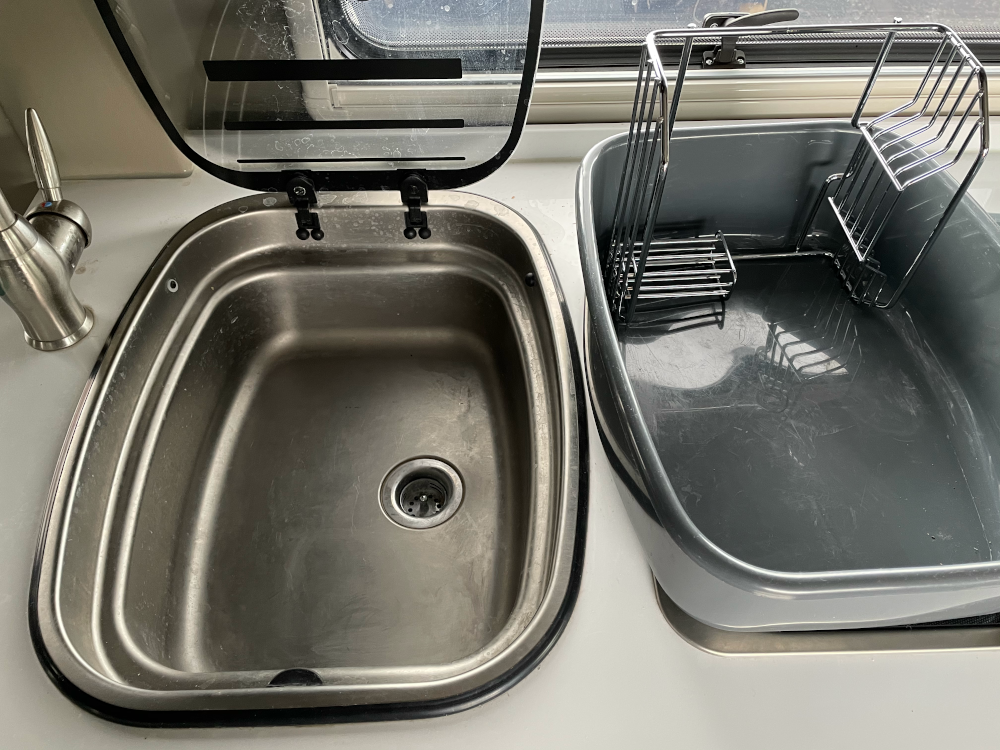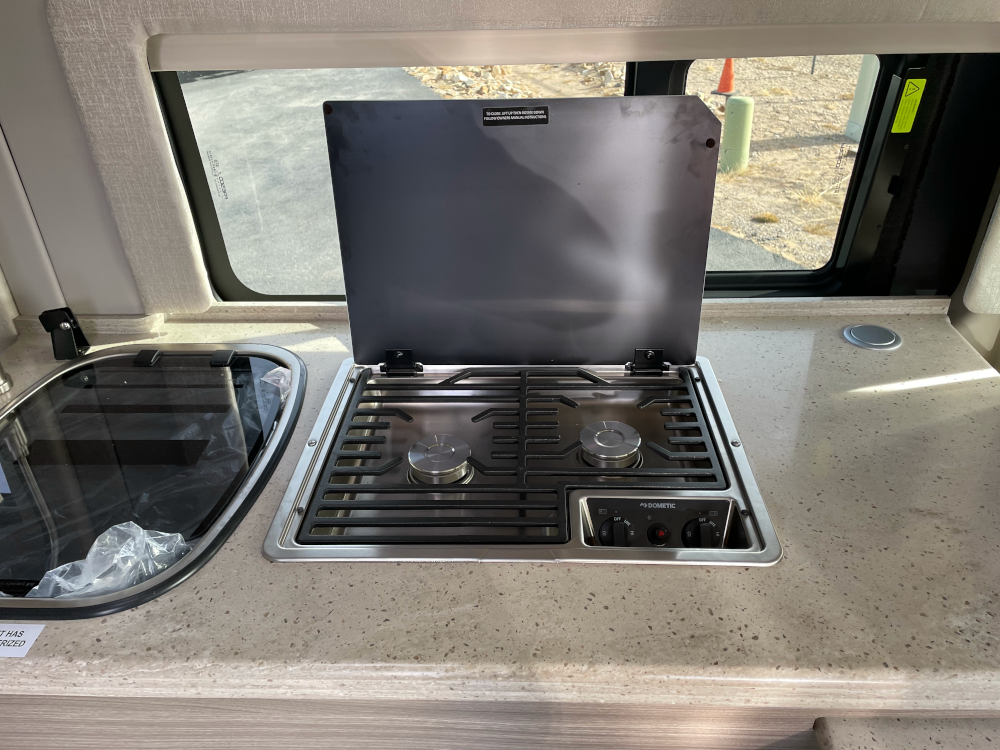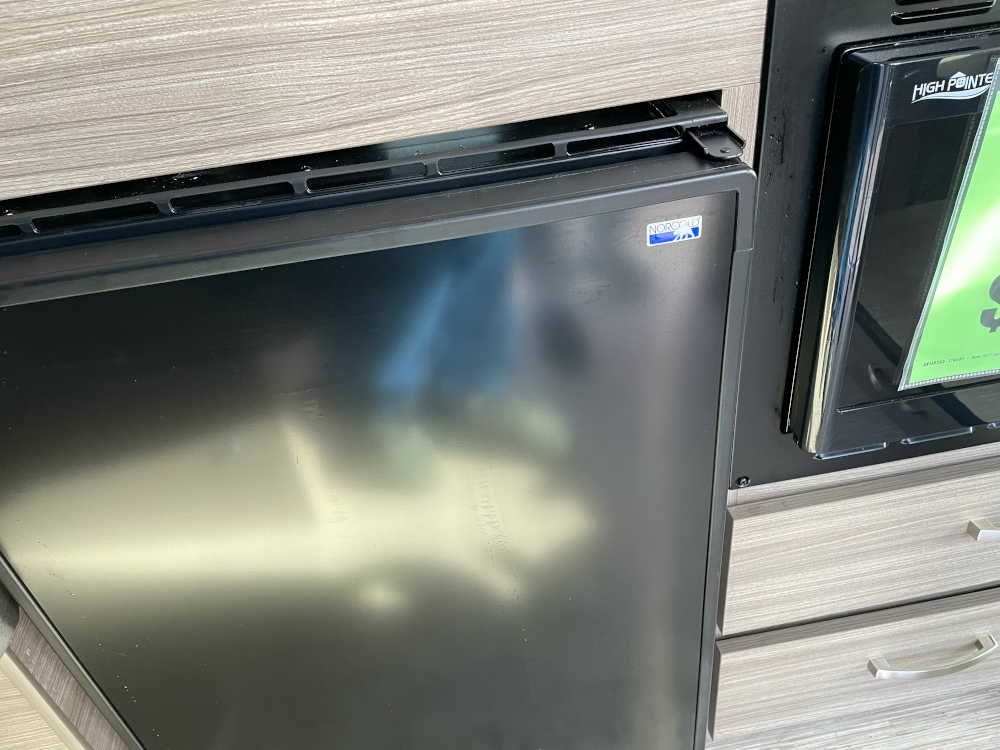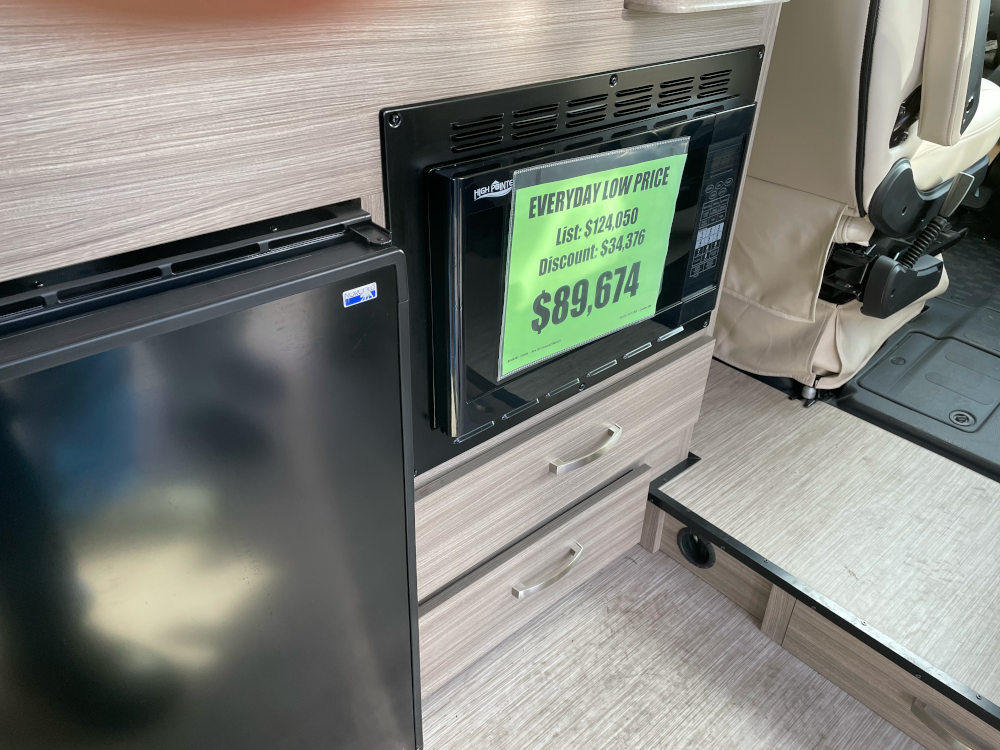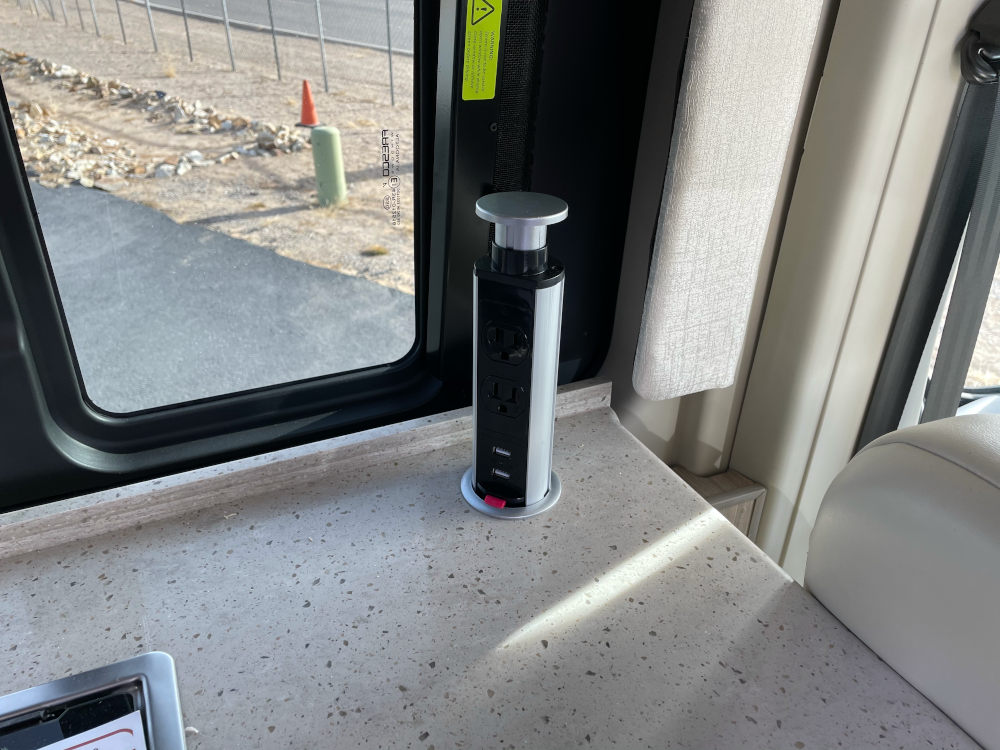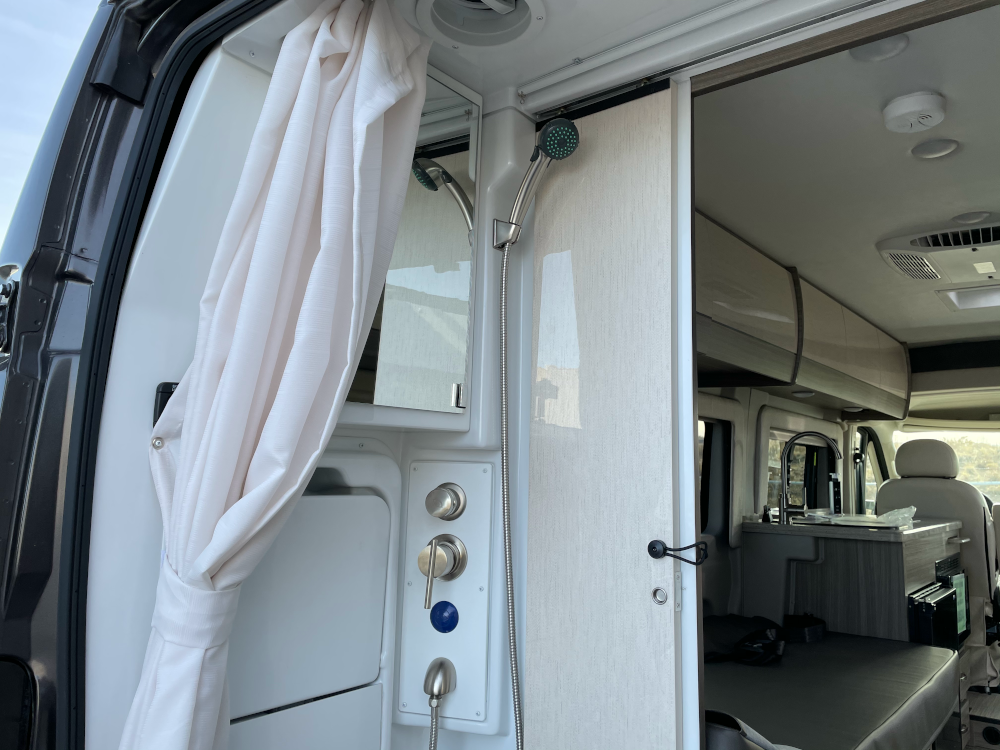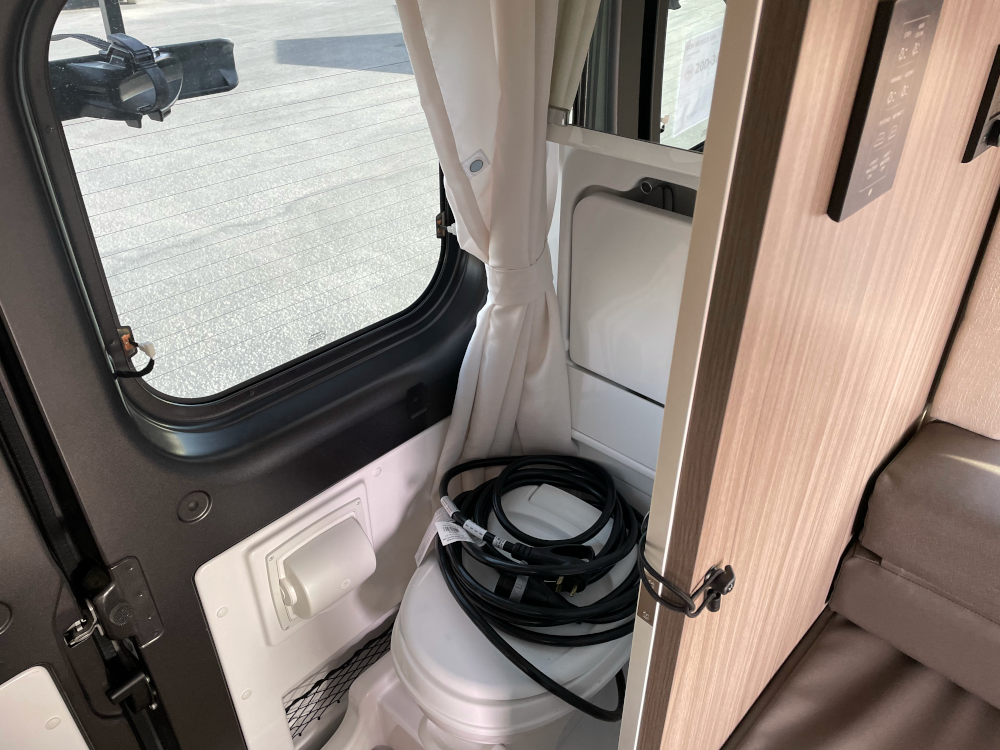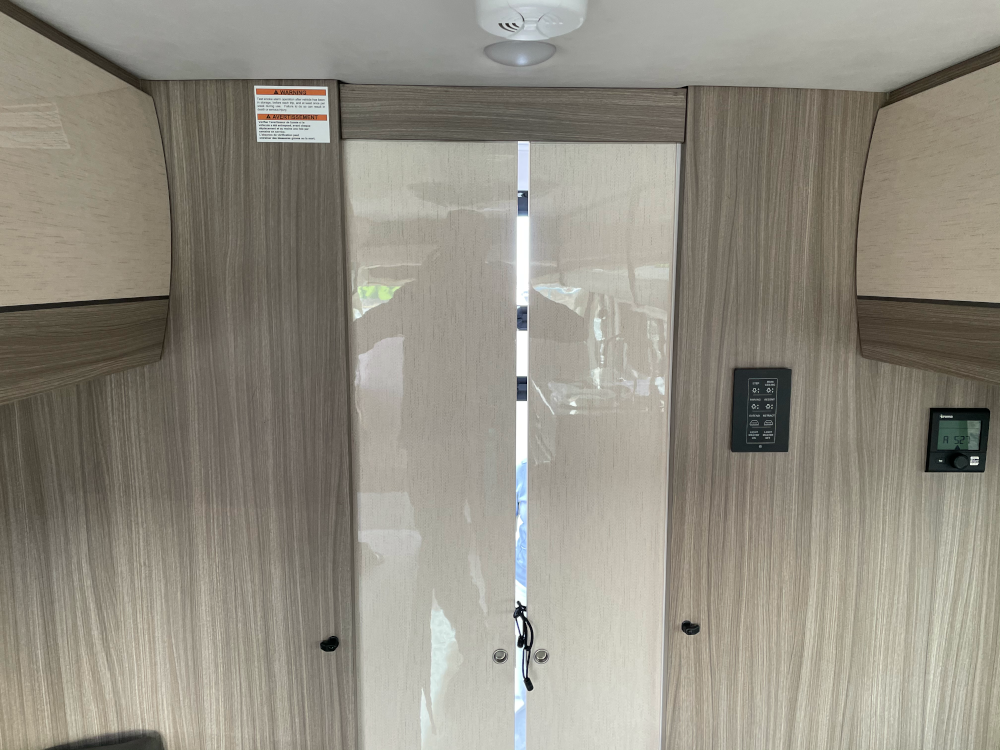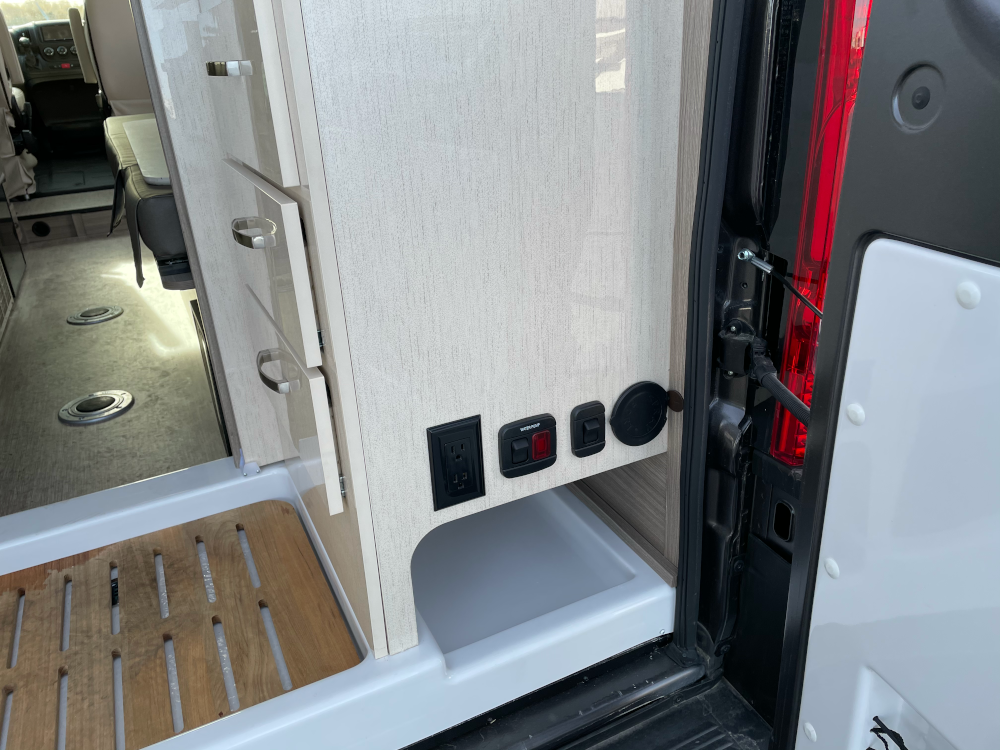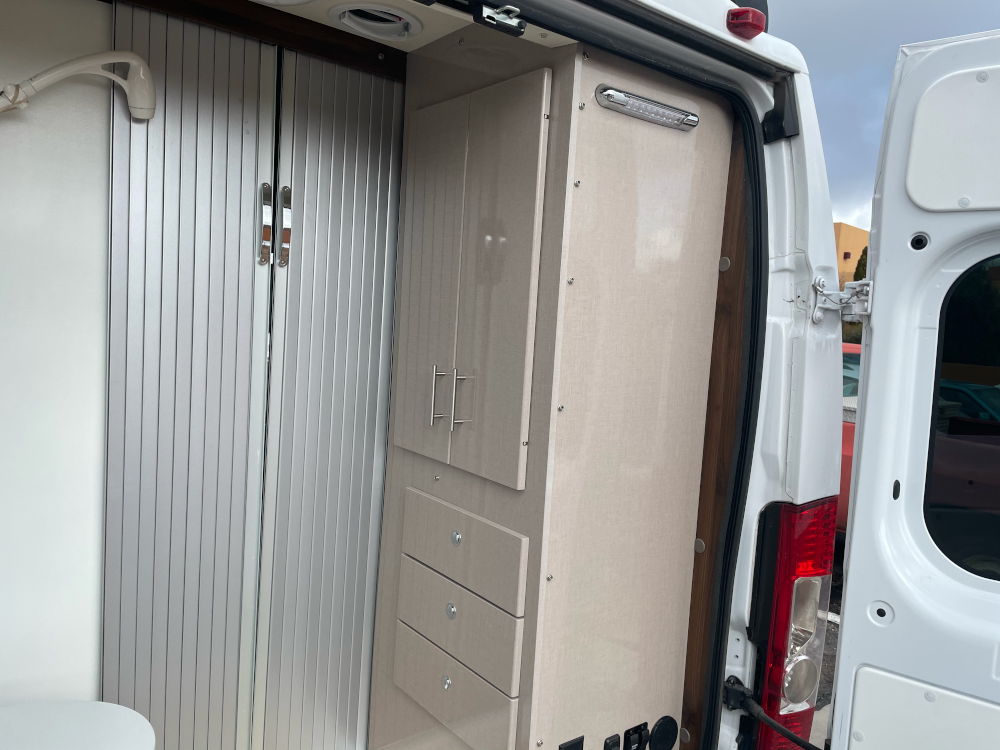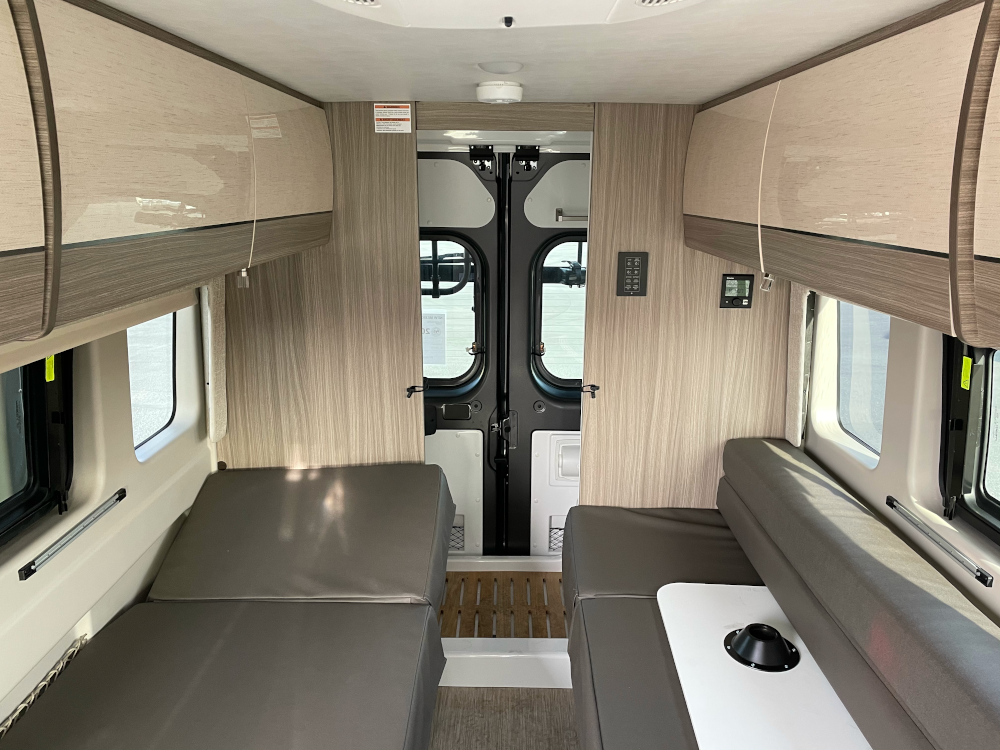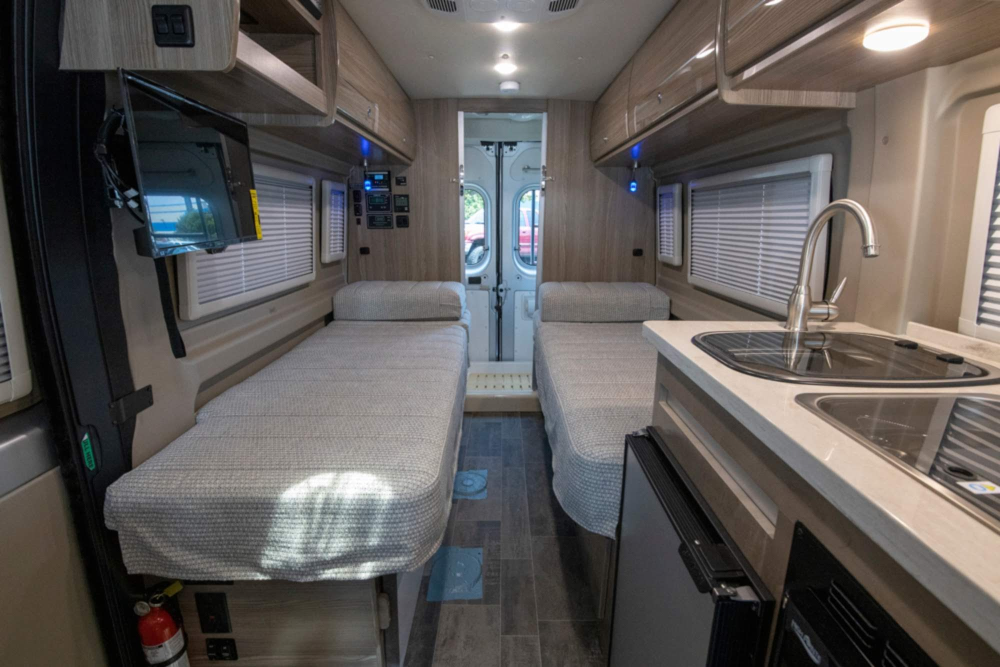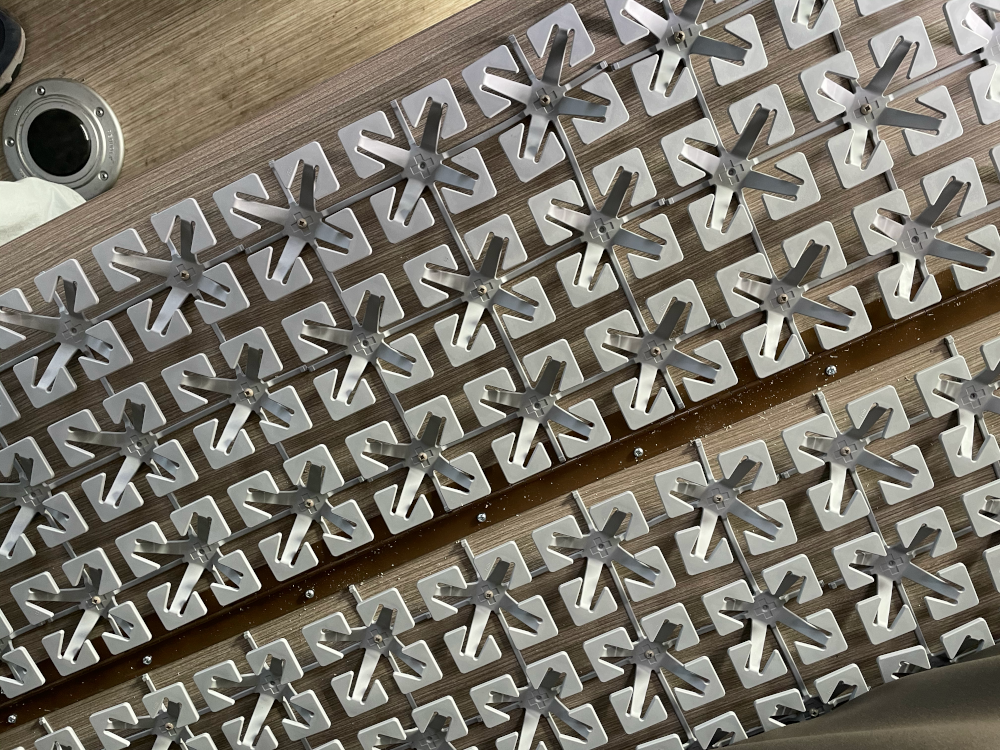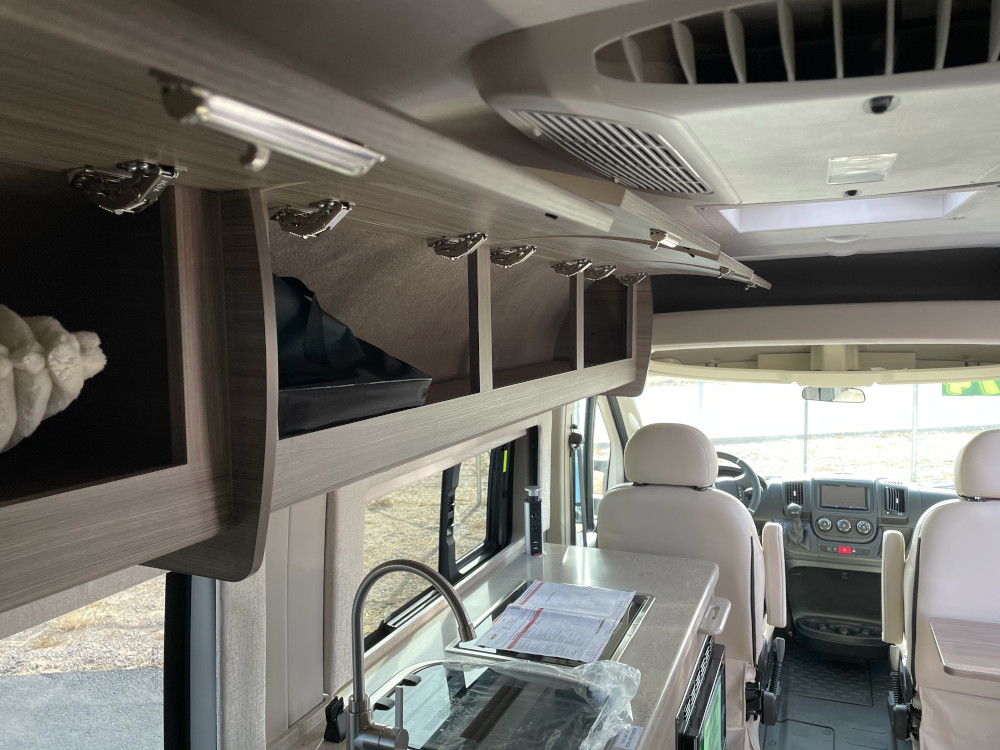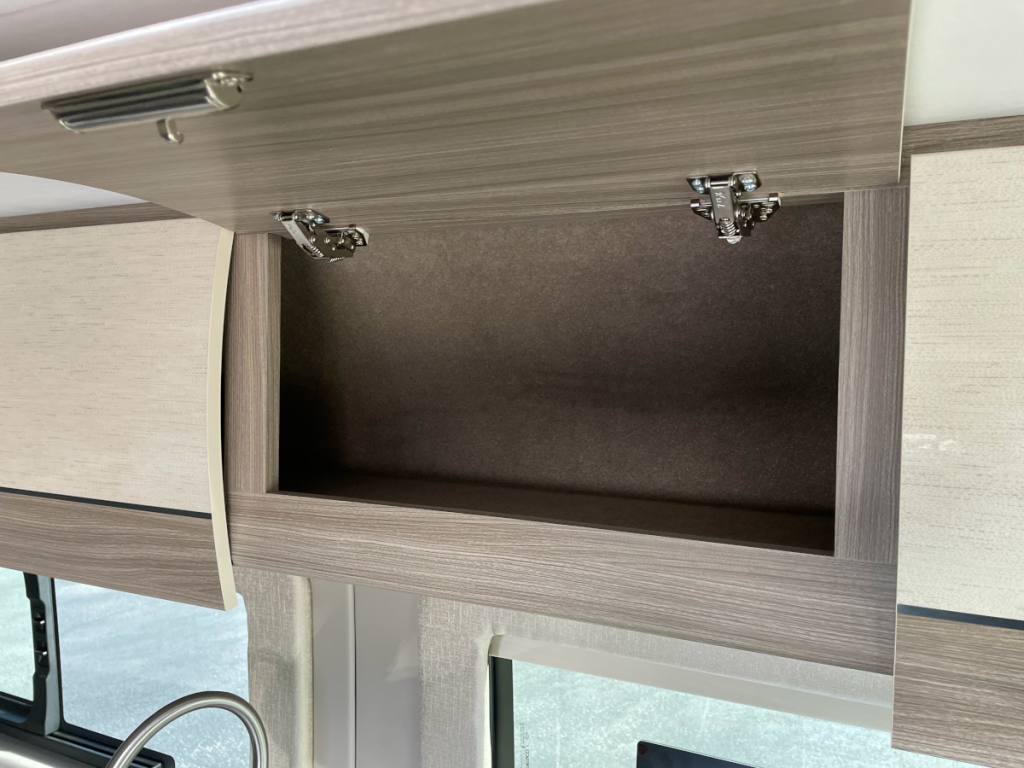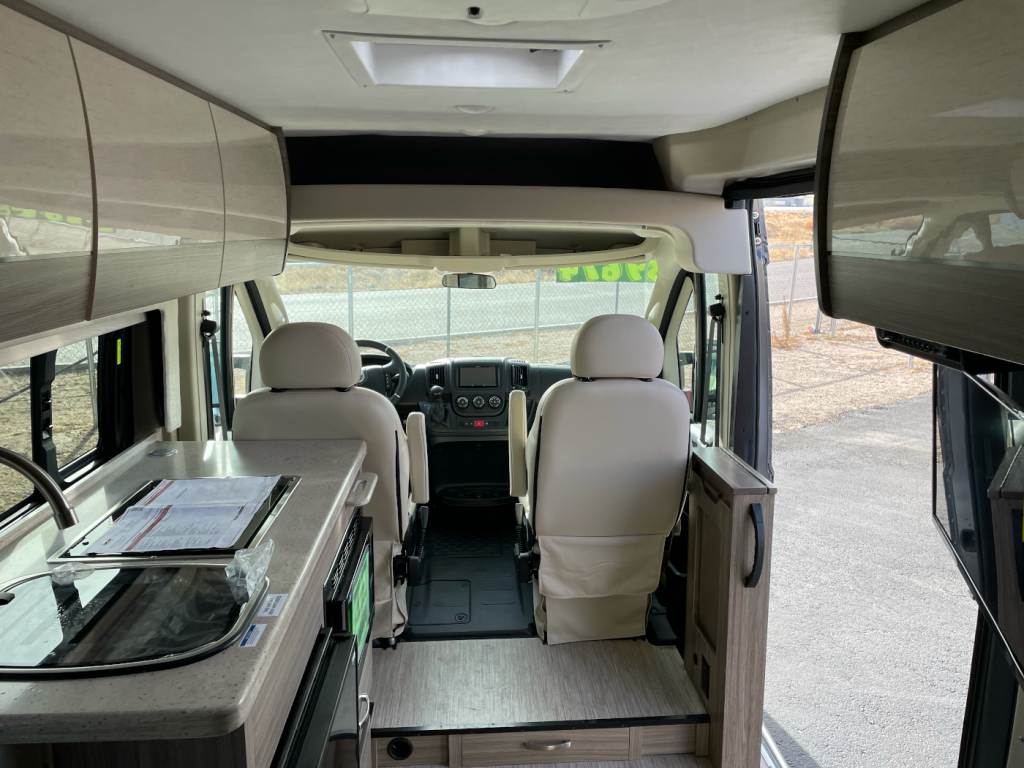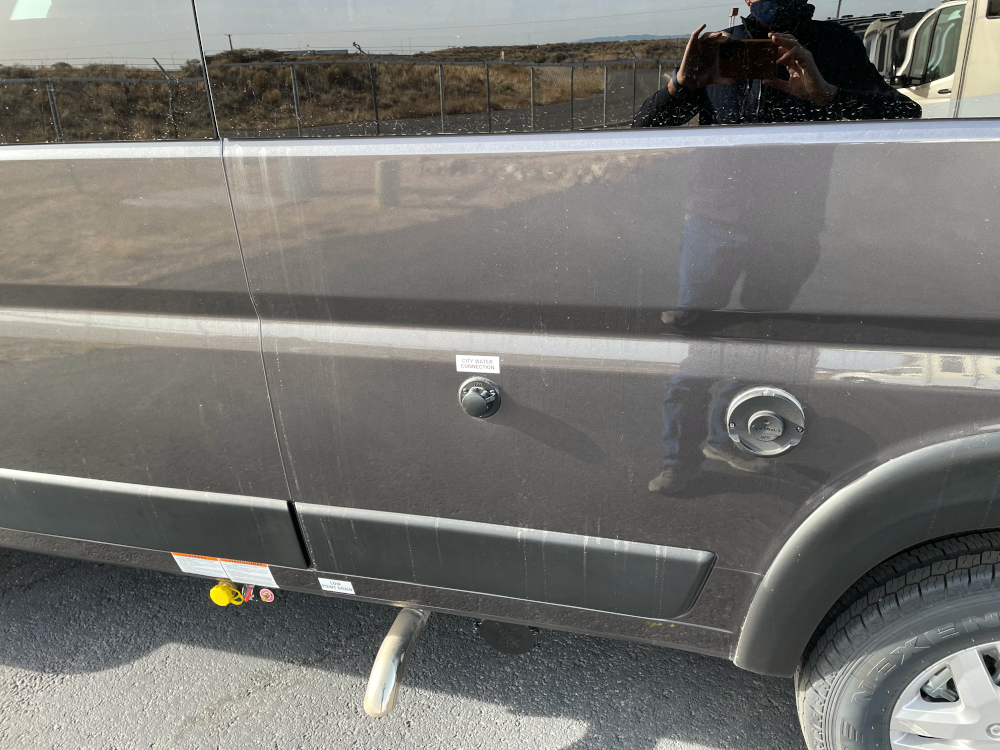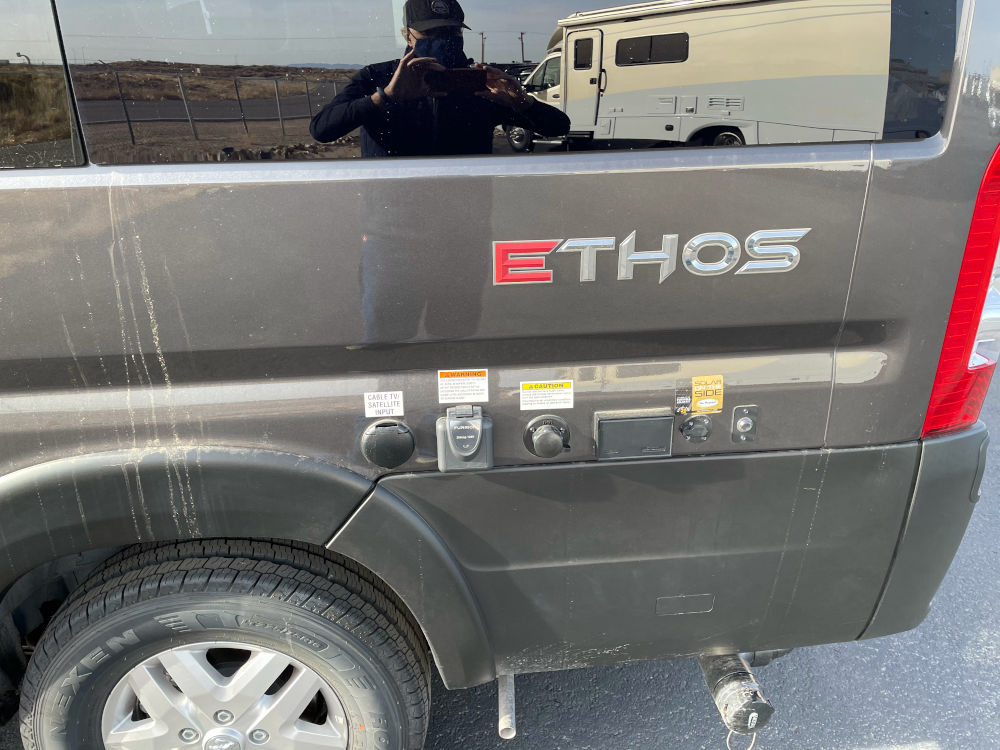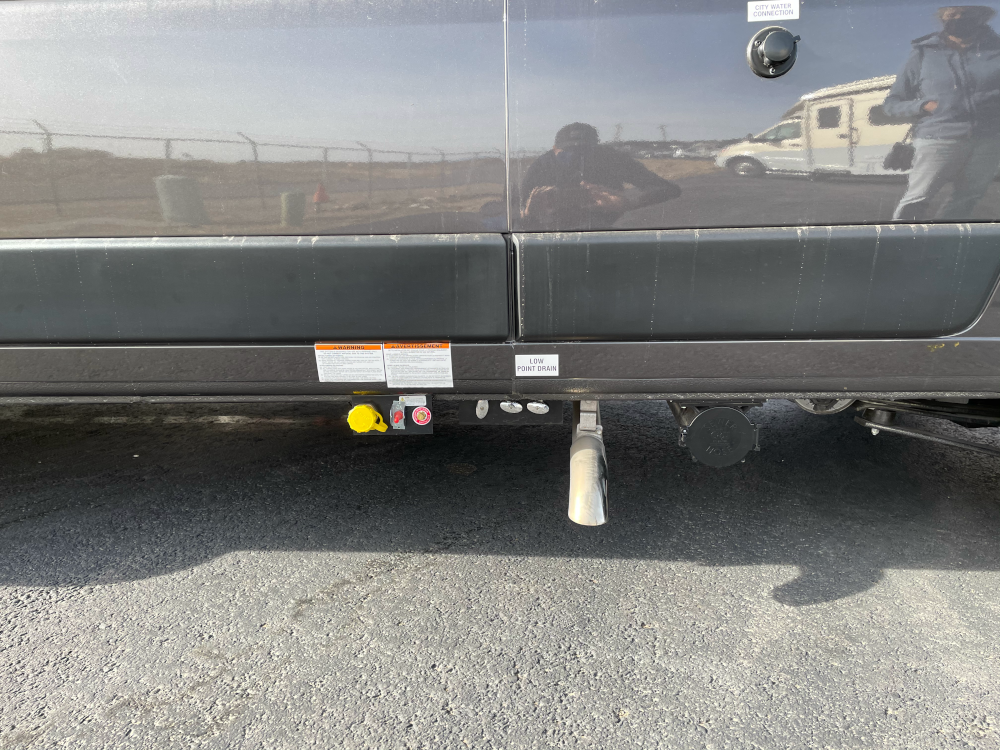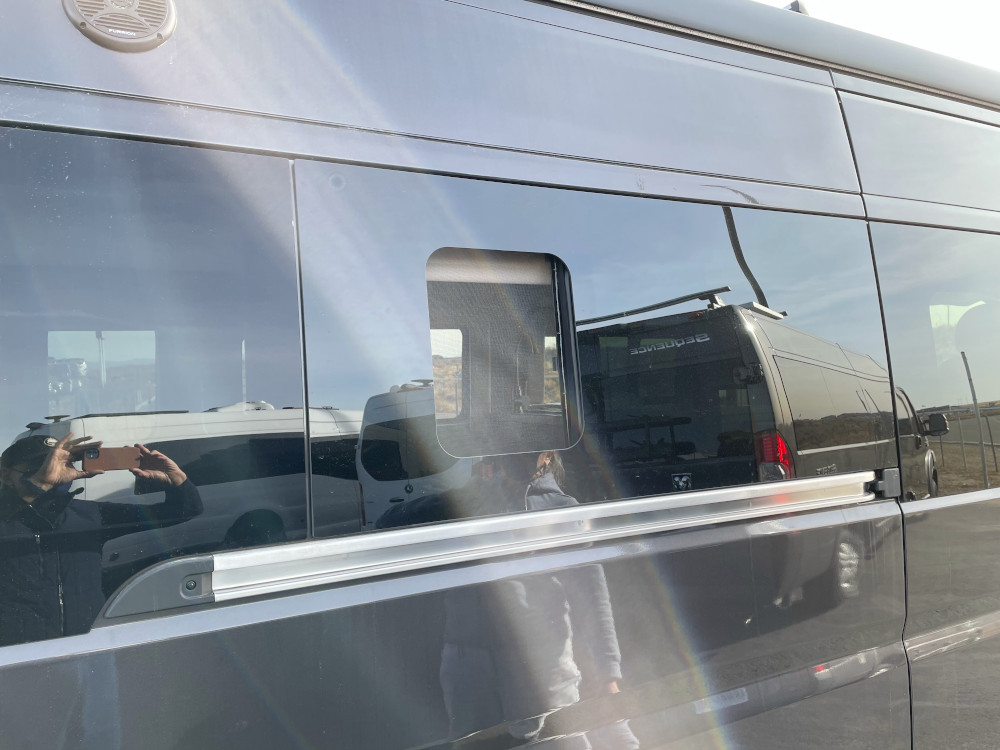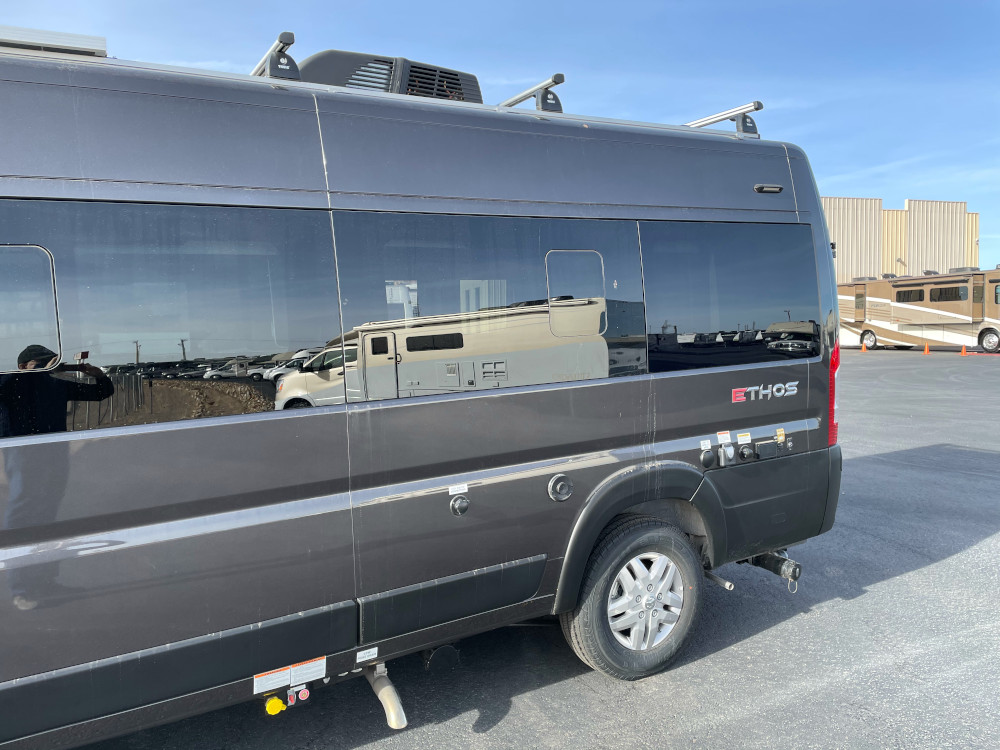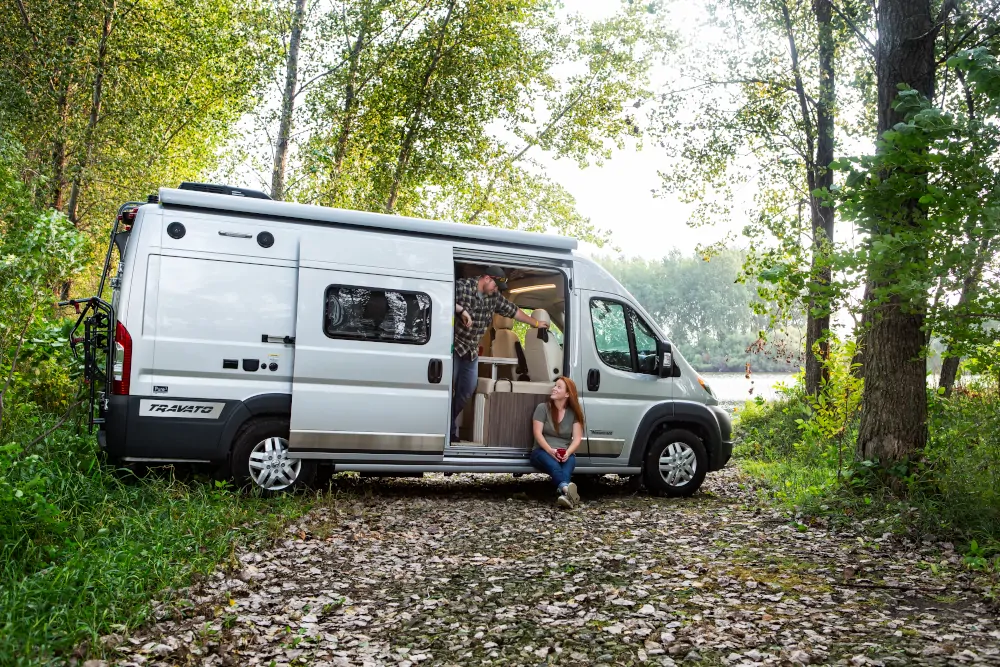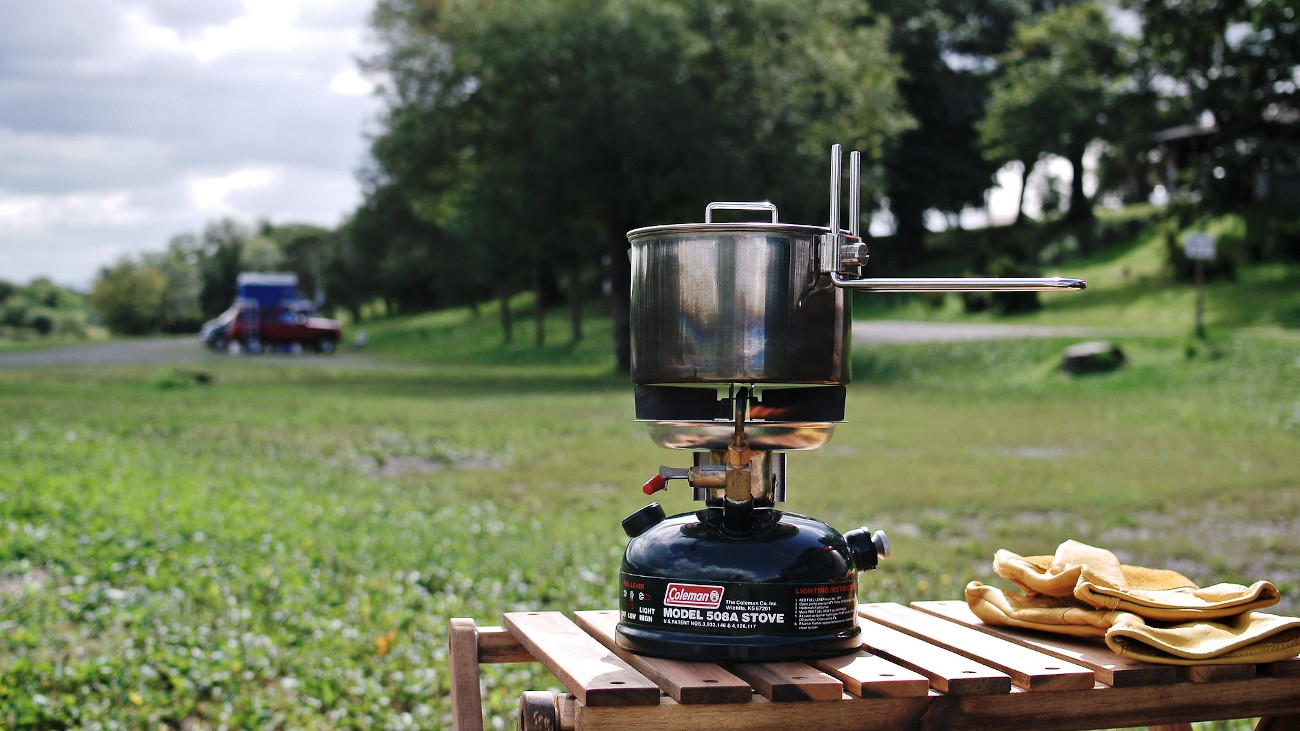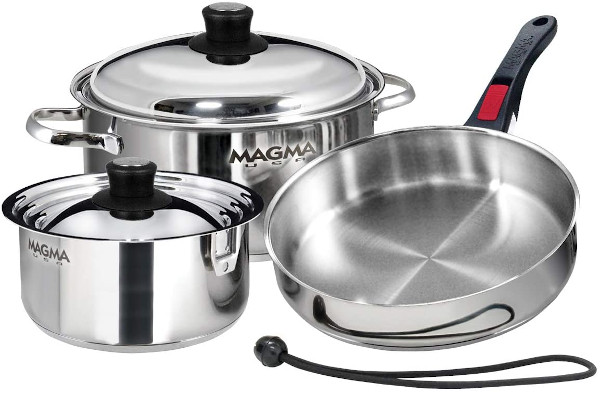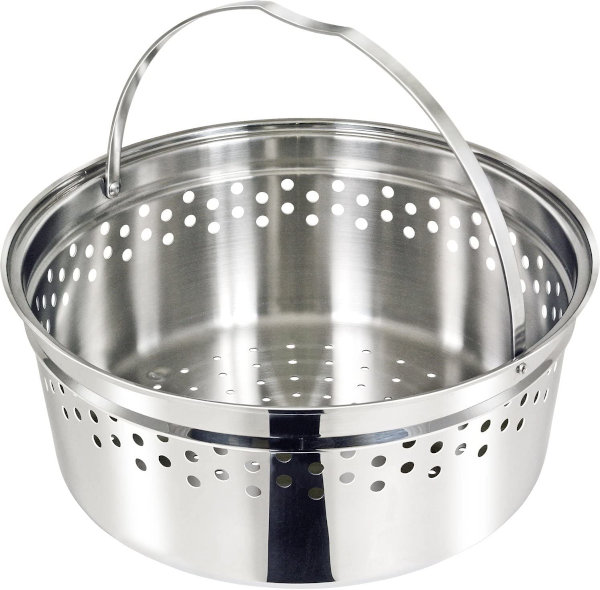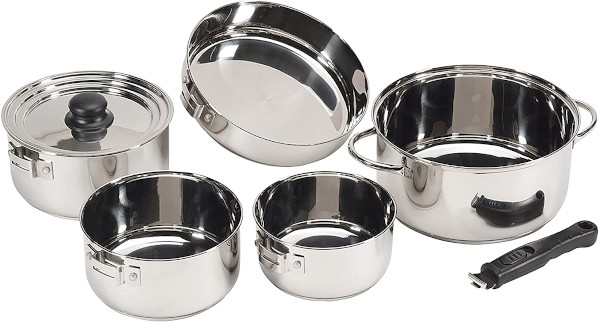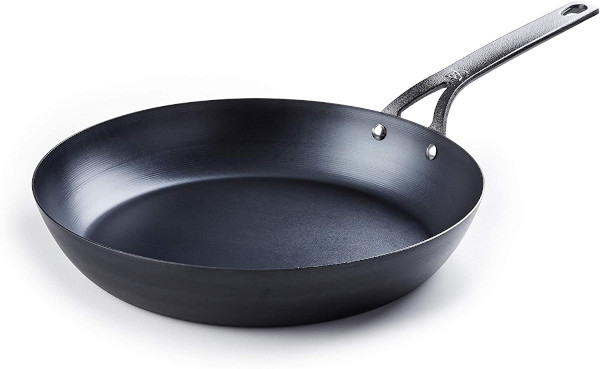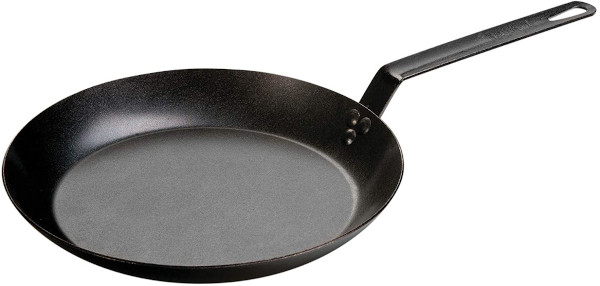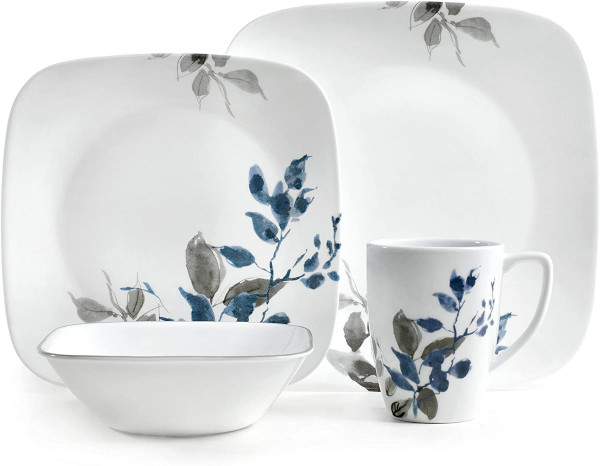Winnebago Solis 59PX
All the images in this post are courtesy of Winnebago Industries, Inc. Unauthorized use not permitted.
In July 2020, Winnebago announced the new 2021 Solis 59PX, to complement the Solis 59P introduced last year. This new Solis, starting at $121,000 is a great affordable van. (The $121,000 is the MSRP and a good deal on a Winnebago van would be 30-35% off MSRP.) The 59P starts at $102,000. So what do you get for the added $19,000 and why do I call it a great affordable van? Read on.
Chassis
As with the 59P, the new 59PX is built on a Ram Promaster chassis, which features:
- front wheel drive
- 280HP 3.6L V6 gas engine
- 258 lbs. feet of torque
- 6 speed automatic transmission 62TE
- 24 gallon fuel tank
The 59PX is built on the longer 21 foot Promaster chassis, which makes it about 18 inches longer than the 59P. The only other chassis differences between the Solis 59PX and the 59P are:
- the 59PX features power mirrors with defrost and turn signal. The 59P comes with manual mirrors.
- the Solis 59PX has aluminum wheels.
- the 59PX has a chrome front grill and fog lamps.
Layout
Here is a side-by-side layout of the 59P (top) and 59PX. As you can see, the main difference between the two, is an 18 inch deep garage to the rear of the bed. While this is the only configuration of the 59PX, the 59P also has a rear lounge configuration.
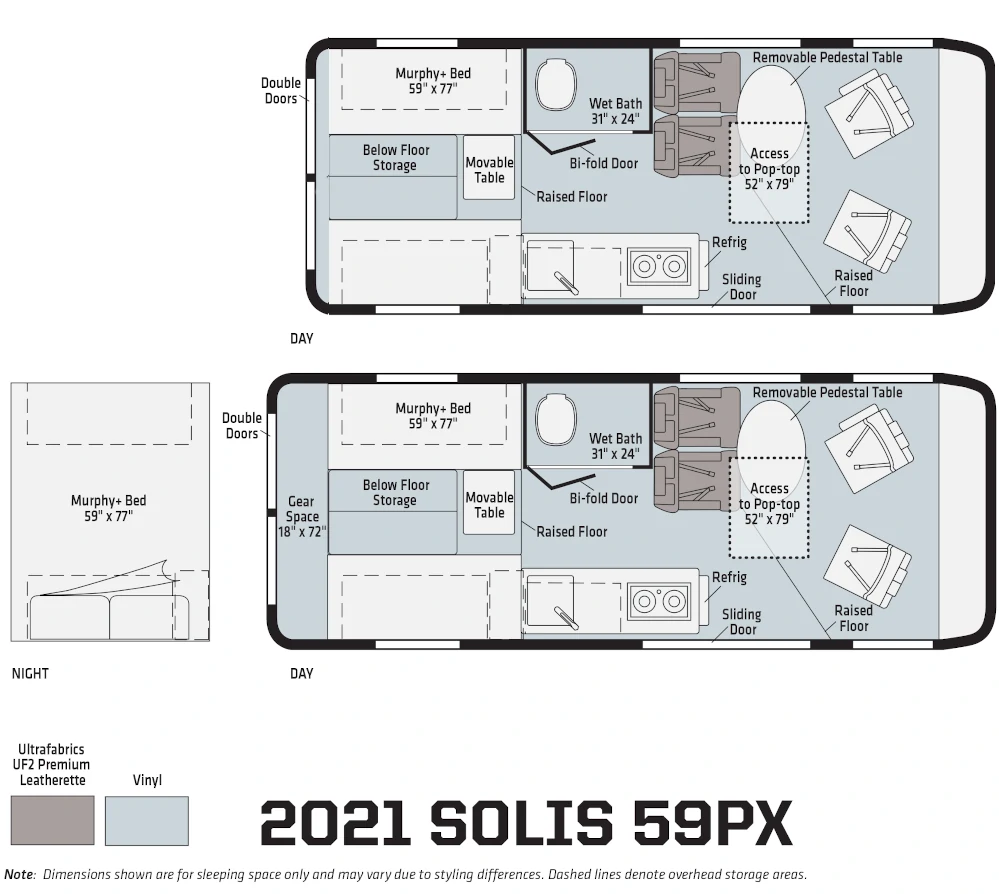
That new rear gear garage is a big deal and enables you to store two bikes and associated gear, or any other gear for your outdoor adventures.
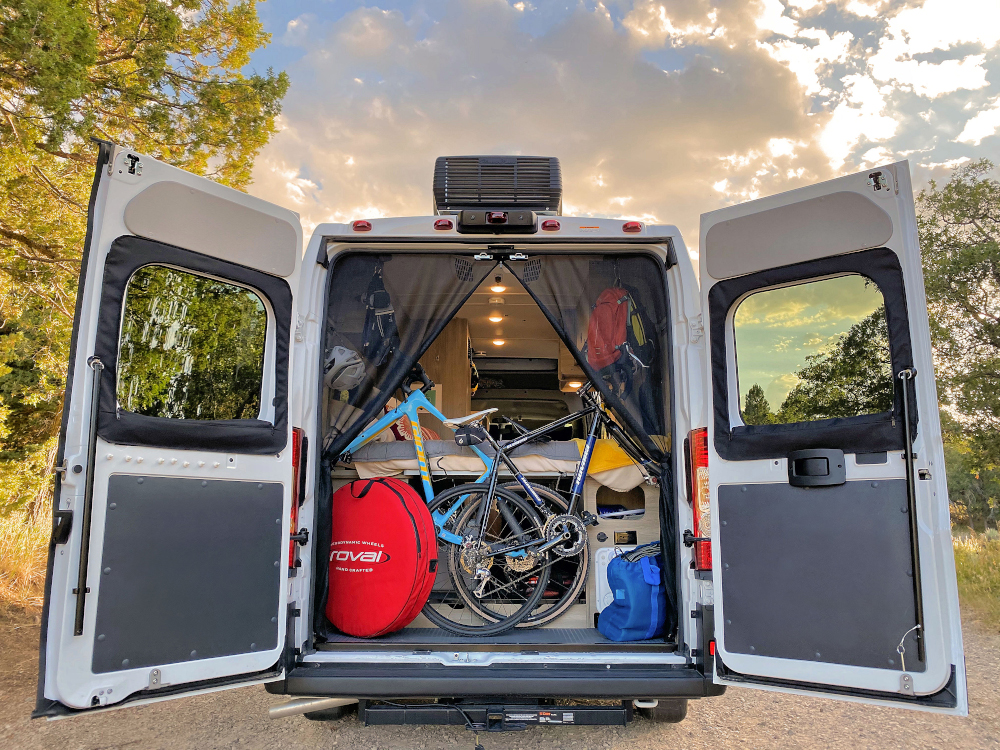
And from a different angle

On the left side of the picture above, you can see three sections of l-track (aka aircraft track): where the helmets are attached, where the blue bike’s front fork is attached, and on the bottom where the wall meets the floor. L-track is a general purpose system for securing gear and in this picture they are using rings with carabiners, and bike fork mounts.

In addition to the garage, this van has an incredible amount of storage for its size. There are storage bins and cubbies everywhere. The murphy bed area features a large but shallow under the floor storage space and storage along both sides of the walkway including a drawer.
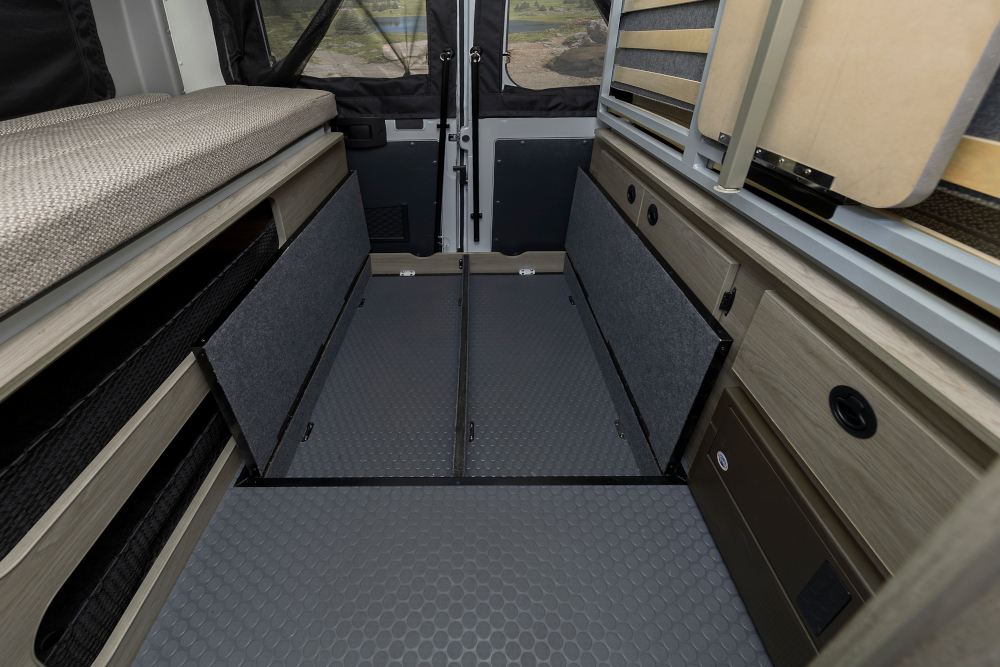

The two pictures above are of a 59P but the storage is the same in the 59PX. You can see that if you keep the bed permanently down, which many do, you have even more storage under the bed. In addition to a number of overhead bins, there is another handy drawer in the galley as well as a good sized under-the-sink cabinet.
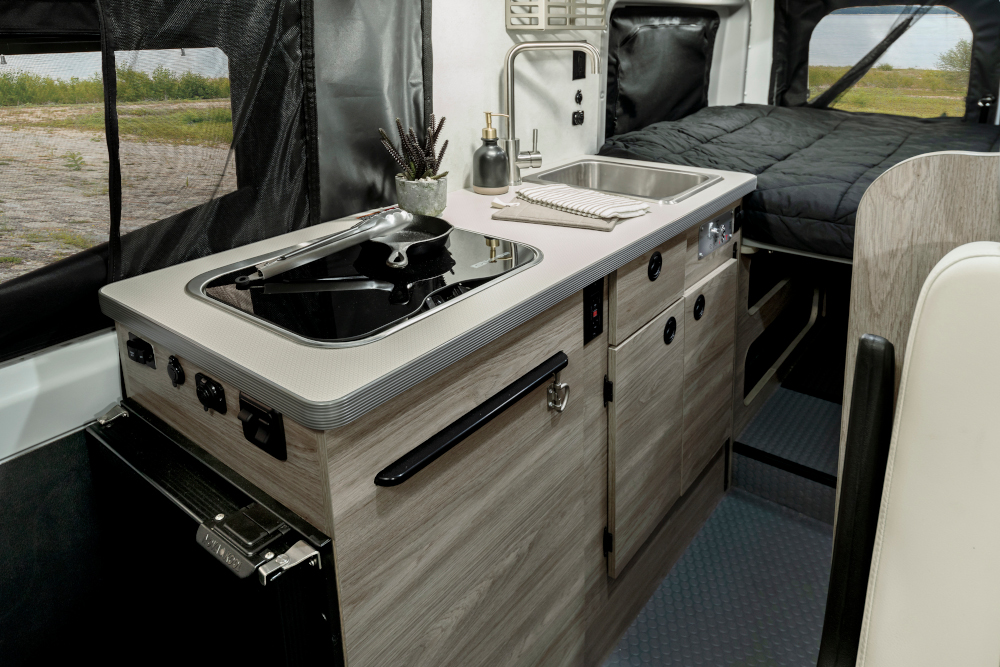
The galley
Moving on to the galley you can see a reasonably sized sink with a tall faucet. There is a 2-burner propane cooktop with a glass cover. On the lower left of the picture above you can see the small 12-volt compressor refrigerator. (If you are looking for a van with a large refrigerator, this isn’t it.) While small, the refrigerator’s placement allows you to access it from either inside or outside the van. There is no microwave. What you gain from its absence is extra storage. . The entire galley is small but functional.
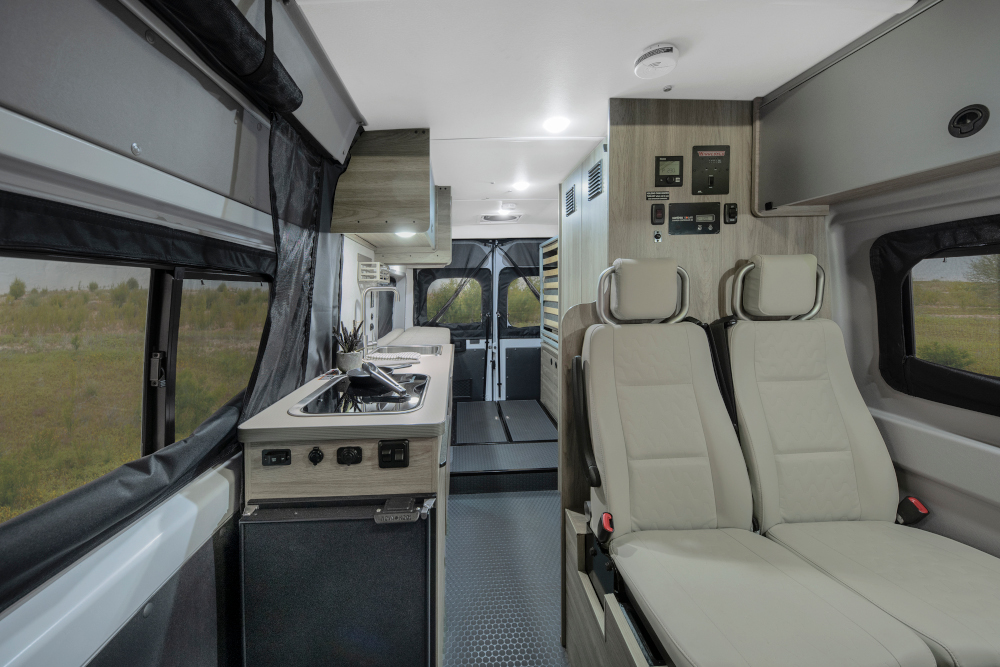
The bathroom
The very compact bathroom is on the driver’s side of the van. It is a wet bath meaning the shower encompasses the entire bathroom space. Effectively, the toilet is in the shower stall. This is typical in Class B camper vans.
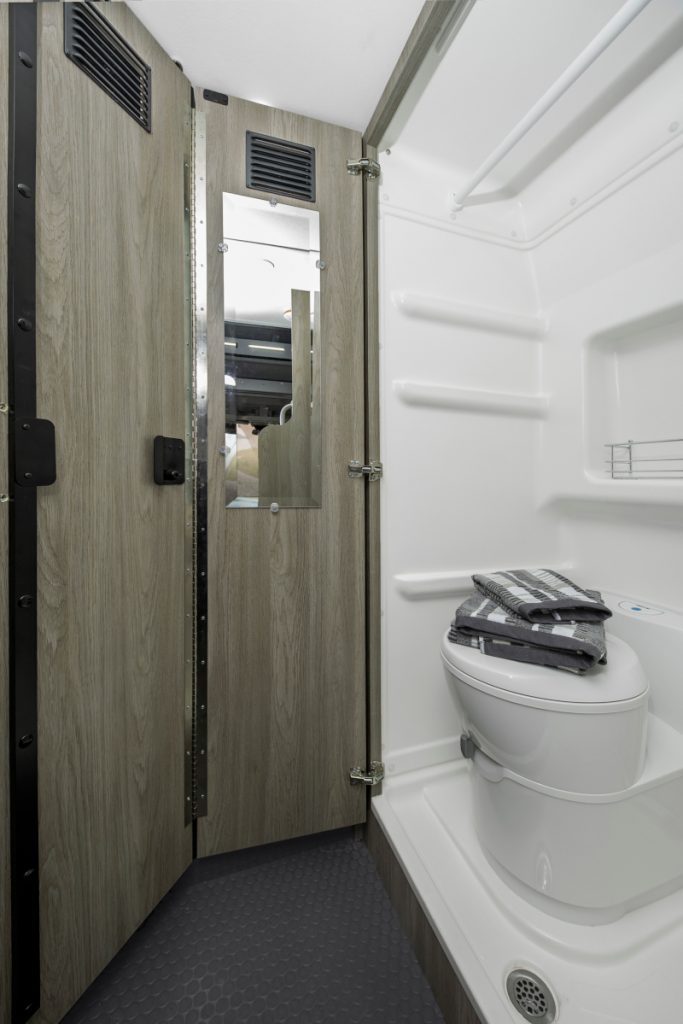
There is a cassette toilet with a swivel head. People are pretty polarized when it comes to cassette toilets so this might be a deal breaker for you or a distinct plus. If you are unfamiliar with cassette toilets please see the entry in our glossary.https://classbvan.com/camper-van-glossary/.
As with the Winnebago Revel, the bath doubles as a place to hang wet gear.
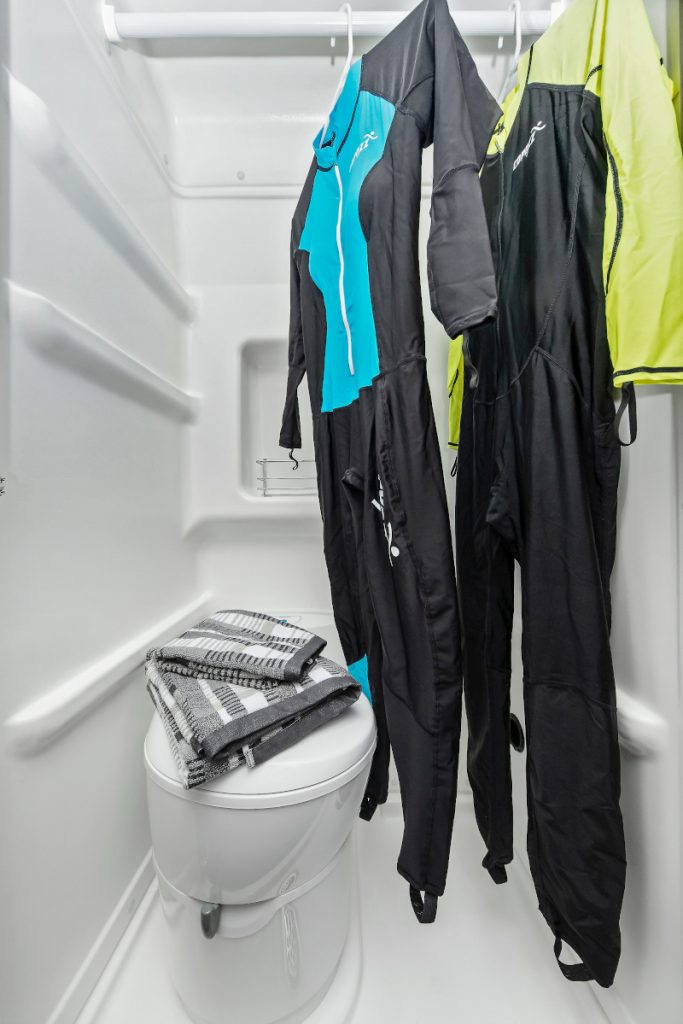
The dining / lounge
Both the driver’s and passenger’s seats swivel to face inside the rig.

Which makes part of a compact yet functional front lounge.
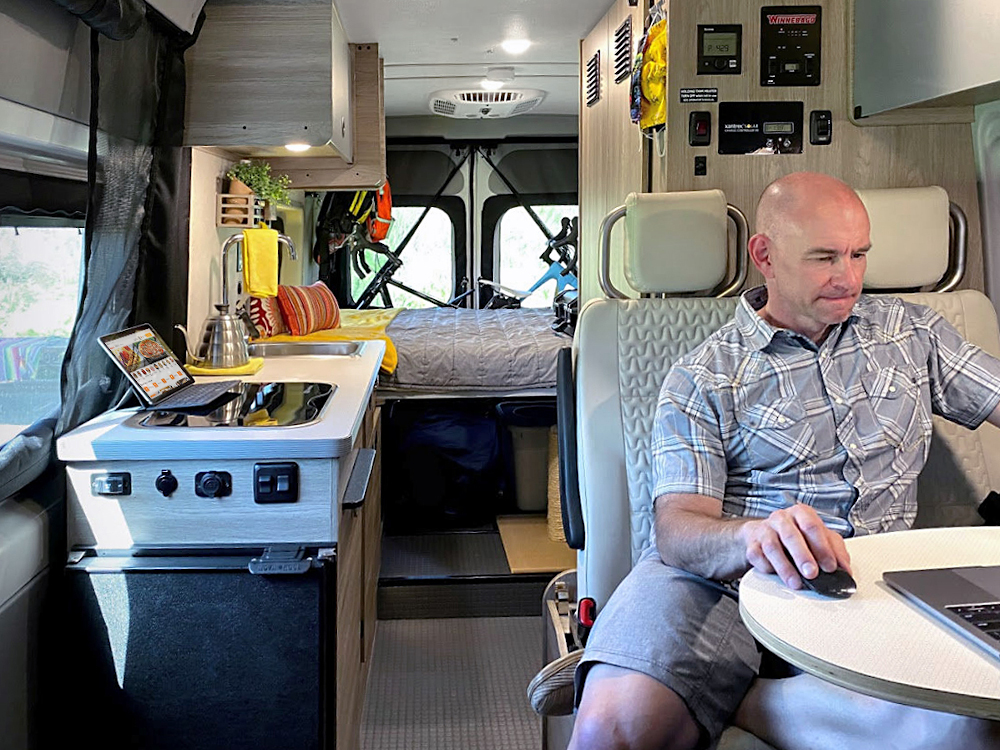
The lounge area features a removable, small, pedestal table. I am guessing here but it looks to be roughly a 30×18 inch oval. It would be small for a two person dining table and small if you need a lot of workspace. It is fine if you just need laptop space. The lounge also features 2 front facing seats with three-point seat belts. As you can see in the picture, those two seats would be a cozy fit for two adults, but it is nice to have that option.
The murphy bed
The murphy bed is a good size for a Class B camper van measuring 59×77 inches. Compare that to a Winnebago Travato 59g that measures only 46×77 or the Thor Sequence 20A which is 66×74. The bed features a slatted frame.
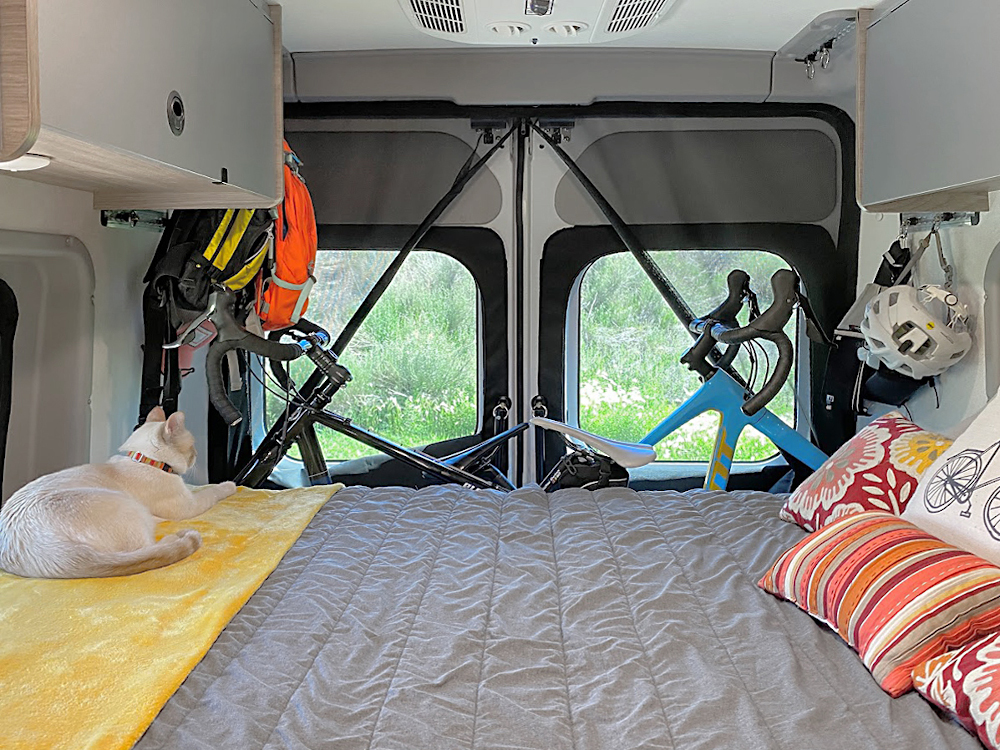
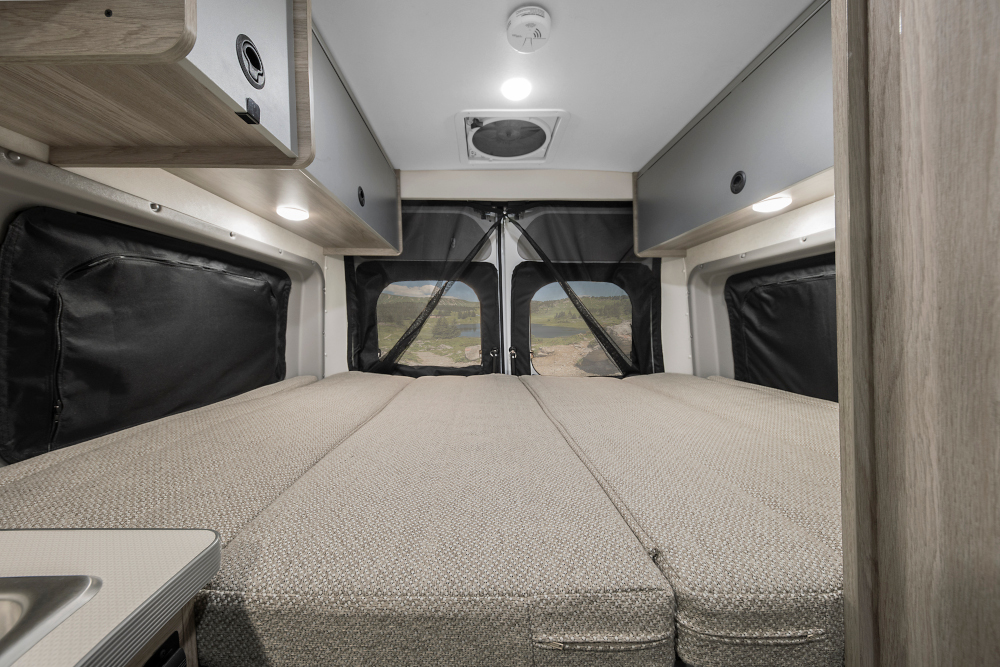
The pop-top loft
You probably noticed on the first picture that the van features a pop-top. The pop-top does not raise the interior height of the van. Rather it functions as a loft with a 52×79 inch bed. You get to the loft by use of a removable ladder in the lounge.
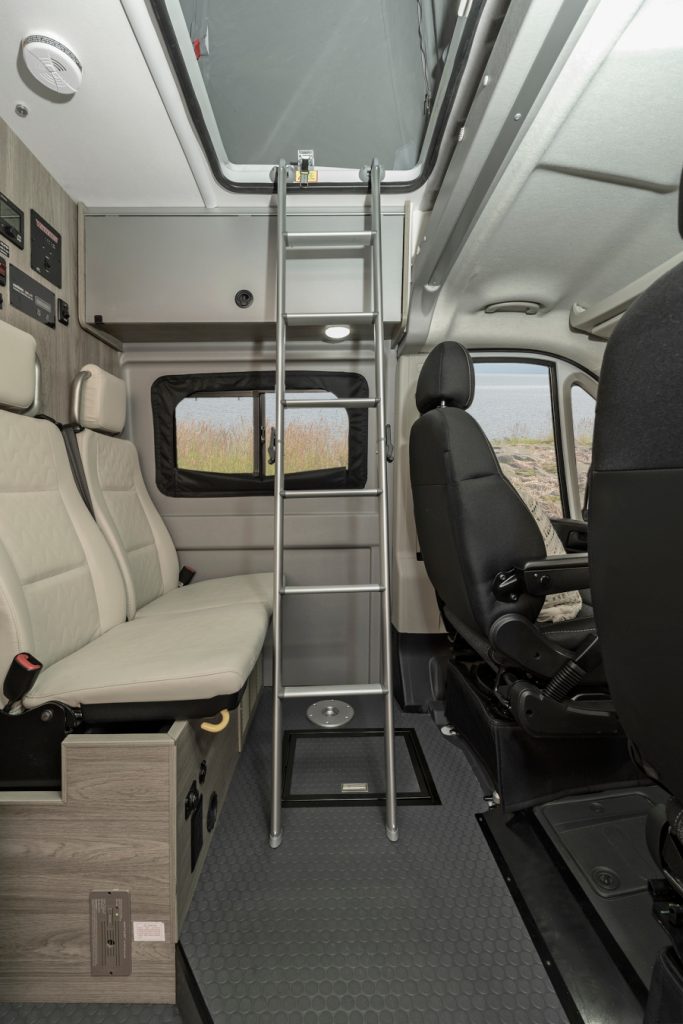

Hardware
Heating and Cooling
When the 59P was introduced last year, many noted the lack of an air conditioner. In a short van with a pop-top it was near physically impossible to include one. With the longer chassis, the Solis 59PX features the new quiet Coleman-Mach 10 NDQ air conditioner. I can attest to how quiet this air conditioner is. You can talk at normal volume and be heard by your travel mate, particularly if you are sitting in the front lounge. Having this air conditioner in the van is fantastic!
Heating is handled by the Truma Combi, an LP, electric system that provides heat and hot water. Truma is a quality brand.
Plumbing
There are several cool, innovative features about the plumbing in this van. For example, when winterizing other Class B vans you generally need to remove a panel or two to reach various valves which might be less than easy to reach. In contrast, the Solis 59PX features a ‘water center control panel’ which consolodates the water valves making winterizing infinitely easier.

You don’t need to scrounge up your manual as the valve settings for winterization are diagrammed on the unit itself. The control panel also contains the connection for the fresh water tank fill, the hookup for an outdoor shower (another is behind the passenger seat) and a water pump switch. Part of its functionality is shown in this Winnebago video.
On many class B camper vans the meter that measures your fresh water is shown in increments of a third. You’ll have an indication when you are full, two-thirds full, one-third full, and empty. The Solis features an old school manometer (a back-lit glass tube in the galley) that artistically and accurately measures the current amount of fresh water in your system.
When using hot water in your house, whether to take a shower, wash your hands, or wash the dishes., you turn on the hot water and watch cold water go down the drain as you wait for the water to get hot. In the process you waste water. This is particularly frustrating in a van when you only have 21 gallons of fresh water–you are wasting a precious resource. While you are waiting you are sending perfectly good fresh water into the gray tank. The Solis features an innovative feature that allows you to purge the cold water back into your fresh water tank. When you turn on the hot water faucet you get hot water.
As I mentioned it has a 21 gallon fresh water tank. The capacity of the gray water tank is 20 gallons and the cassette toilet holds 5.
Electrical
The Solis has 2 AGM batteries for a total of 220 amp hours. It has 220 watts of solar panels. There is no lithium option. It features the Cummins Onan® QG 2,800-watt gas generator. It is quieter than a traditional RV generator producing 70 decibels at 10 feet at half load. It is significantly quieter than the previous generation Cummins generator I have on my van. The Solis has a traditional 30 amp hookup to an external source.
There is a plethora of 12 volt DC and 120 volt AC outlets throughout the van.
Other details
Okay, this may come as a shock to some, but the Solis does not have an awning. For the cons of van awnings see the humorous FitRV’s An Offbeat Look at Why I Don’t Like RV Awnings
Because of the pop-top there is no powered roof vent.
The windows are traditional sliding glass windows and not the dual-pane acrylic that some prefer.The Winnebago Solis also eschews traditional RV window blinds and screens and instead opts for a fabric solution also found in the Airstream Basecamp among others.
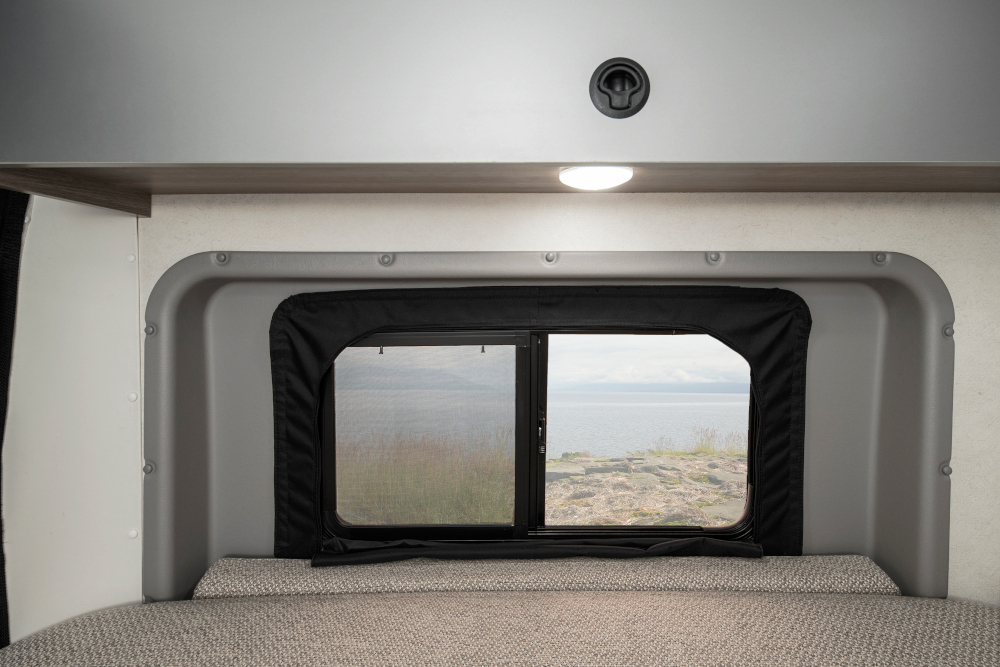
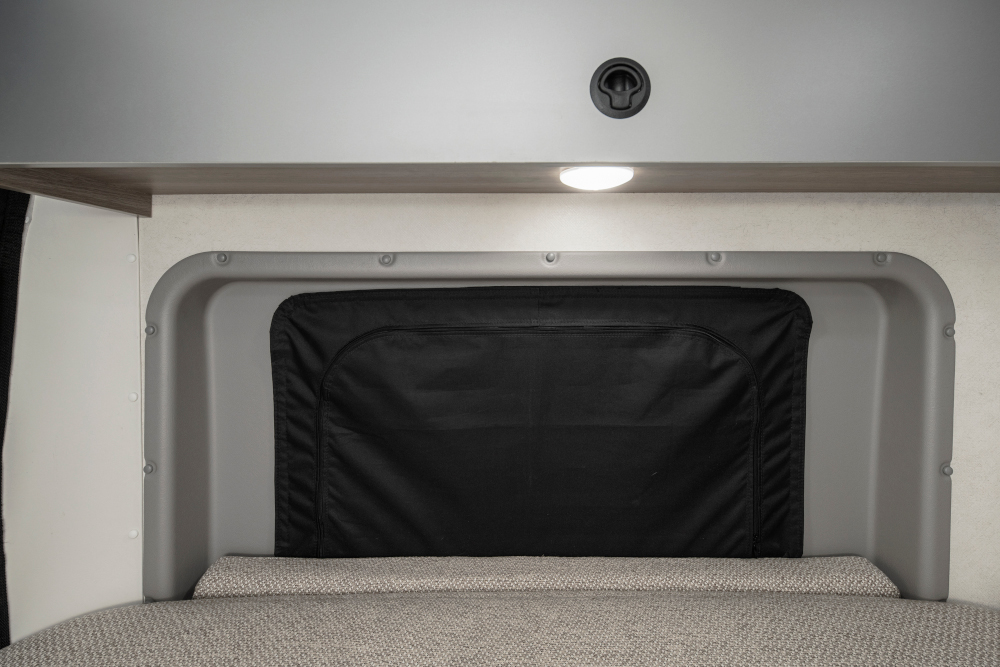
Exterior
As the first picture in this post shows, the exterior is very clean and contains the features you would expect.
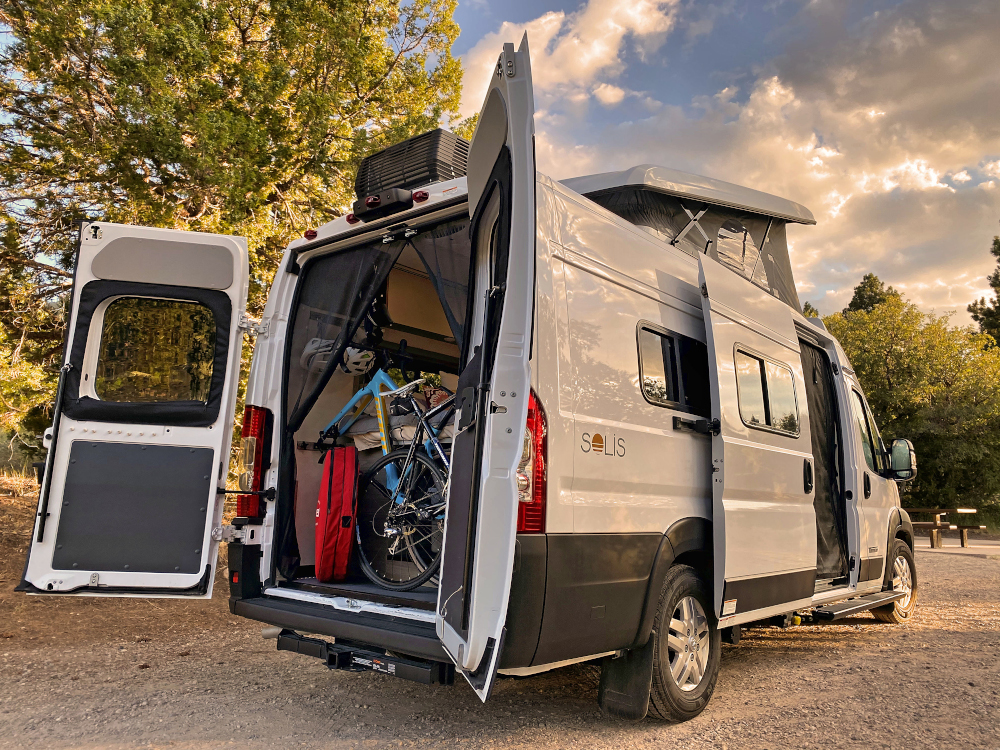
Summary
I like this van. The price is great and it contains a number of innovative features. It has an impressive amount of storage space, a comfortable size bed, and a functional lounge, galley, and bathroom. If I were in the market for a van this would be on my short list.
Video walk throughs
The original Solis 59p
Most of the features described in the video are true of the 59PX.
FitRV's walk through of the Solis 59PX
Camper van glossary
Glossary text
3-Way Refrigerator
Refers to a refrigerator that can run off of LP gas, 12V battery power, and shore power. Also called an absorption refrigerator. While being able to run off of LP gas is a plus, it is not as efficient as an electric compressor refrigerator. Moreover, the van must be level in order for a 3-way refrigerator to run correctly and safely.
AGM Battery
Absorbed Glass Mat battery, so named because there are fiberglass mats between the plates of the battery. They are spill proof, tolerant of vibration, and they do not give off any hydrogen gas. They were developed in the 1980s for military aircraft and are perhaps the most common battery for Class B camper vans. The main disadvantage is that they can only be discharged to 50% meaning a 100 amp hour battery only has 50 amp hours of usable power.
Black Tank
The black tank is primarily the sewage reservoir for the toilet. It may also contain the waste water from sinks or showers.
BLM
Bureau of Land Management. It manages over 12% of the land in the United States including over 200 wilderness areas. Many boondocking sites are on BLM land.
Boondocking
The term is used for free camping. Under most uses it is synonymous with dry camping meaning camping outside of an established campground without any electric, water, sewage hookups and without any amenities like toilets, showers, or a camp store. In its prototypical use it means camping isolated from others in a forest or BLM (Bureau of Land Management) land. Some have expanded the use to include any camping without hookups such as at a Walmart, Cracker Barrel, or Harvest Host site.
Cassette Toilet
In most RVs, the toilet is positioned over a large permanent holding tank (called a black tank) of ten gallons or more, which is under the floor of the RV. When the time comes to empty the tank, you drive the RV to a dump station where the contents are emptied using a sewer hose. In a cassette toilet, the toilet includes a small removable holding tank (the cassette). When the time comes to empty the tank, you remove it (typically accessed from a small door on the outside of the van). You then carry the tank to a public toilet or to a dump station where you can empty it. That is the advantage the cassette toilet has over the more traditional toilet: you can empty it anywhere. The disadvantage is that you have to empty it more frequently since it only holds five gallons. Another disadvantage is that it is heavy to lug around, although many cassettes have wheels and telescoping handles. As opposed to a portable toilet, the cassette toilet is permanently installed in the van. The cassette toilet includes a small fresh water holding tank which is used for flushing.
Chassis Battery
The battery that is similar in function to your car battery is called the chassis battery. This battery powers the drive train, the instrument panel, the dash radio. Basically anything involved in driving the van. See also house battery.
City Water Connector/Inlet (aka city fill)
The city water connector on your van allows you to connect your van to an outdoor water faucet using a drinking water safe hose with standard garden hose type connectors. This connection bypasses your fresh water holding tank and the water pump in your van. In your everyday experience, when you turn on an outdoor faucet, water gushes out of it, and we say the water is pressurized. The city water connector transmits water under pressure to your van so when you turn on a faucet in your van water gushes out of it without needing your water pump. It is highly recommended you use a pressure regulator for this connection to prevent damage to your van’s water system. Some van travelers never use this connection, opting to use the tank fill.
The city water connector on your van allows you to connect your van to an outdoor water faucet using a drinking water safe hose with standard garden hose type connectors. When you turn on an outdoor faucet, water gushes out of it, and we say the water is pressurized. The city water connector bypasses the
Driveway Surfing
A concept similar to couchsurfing but instead of staying on someone’s couch, you park your van in someone’s driveway (or somewhere on their property). Typically the driveway’s owner is a relative, friends, or fellow traveler. No money changes hands. This is also known as moochdocking.
Dry Bath
A dry bath is similar to what you have at home. The shower is in its own space in the bathroom. The toilet is not in the shower stall. This contrasts with a wet bath is where the shower encompasses the entire bathroom space. When you shower in a wet bath you will get the toilet and possibly a sink wet. A wet bath is designed for this and is not a big deal. Most Class B camper vans have a wet bath.
Dry Weight
The dry weight is the weight of the van from the class B manufacturer not including any liquids (gas, water, etc). For example, a ProMaster 3500 commercial van weighs 5,070 pounds and the manufacturer may add 2,260 pounds (interior cabinetry, refrigerator, heating, coolling, etc). So in this case the dry weight is 5,070 + 2,260 or 7,330 pounds. (see GVRW)
Dump Station
A place for dumping your black and gray tanks. Dump Stations are most often found in campgrounds. However, some rest areas, truck stops, and municipalities have dump stations as well.
Full Hookups
At a campsite, the ability to hook up your fresh water and sewer lines and your electric power cord.
GAWR
Gross Axle Weight Rating. These will be specified for both the front and rear axle. This is the amount of weight that axle can safely carry. (see GVRW)
GCRW
Gross Combined Weight Rating. This is the combined weight of GVRW (everything including the van itself, passengers, food, water, gear) and the weight of what can be towed.
Gray Tank
The gray tank is the waste water holding tank for one or more sinks and possibly the shower. It does not contain sewage.
GVRW
Gross Vehicle Weight Rating. This is the weight (typically in pounds). This represents the maximum weight of everything. The van itself, the passengers, dogs, food, water. Everything except what you are towing. The dry weight is the weight of the van from the class B manufacturer not including any liquids (gas, water, etc). For example, a ProMaster 3500 commercial van weighs 5,070 pounds and the manufacturer may add 2,260 pounds (interior cabinetry, refrigerator, heating, coolling, etc). So in this case the dry weight is 5,070 + 2,260 or 7,330 pounds. The GVRW minus the dry weight is how much you can carry in your van. So, if the GVRW is 9,350 and the dry weight is 7,330, that means you can carry 2,260 pounds, which includes water, passengers, and any gear you carry. If you are carrying 20 gallons of water in your tank (160 pounds), a full tank of gas (144 pounds) and you and your passenger weigh 150 pounds each that would leave you with 1,656 available for gear.
Holding tank
The reservoir for waste water. (See entries for black tank and gray tank.)
House Battery
The battery that is similar in function to your car battery is called the chassis battery. This battery powers the drive train, the instrument panel, the dash radio. Basically anything involved in driving the van. In contrast the house battery (or coach battery) powers everything that makes the van a camper van: the interior lights in the living area, the ventilation fans, the refrigerator, and other electrical devices. If you have solar panels on the roof of your van, they charge the house battery.
Inverter
An inverter is an electrical device that coverts battery power (usually 12V) to house current (120AC) so you can run normal household devices like laptop chargers and a small coffee maker. It is recommended that you use a pure sign wave inverter because it better mimics the 120AC current that appliances expect.
Moochdocking
See driveway surfing.
Portable Toilet
As the name suggests, a portable toilet is one that can be completely removed from the van. It is not permanently installed. This differs from a cassette toilet which is permanently installed (see glossary entry). Often you can get a mounting plate which will secure the toilet to the van while traveling. The toilet consists of a small tank of fresh water for flushing and a small detachable waste tank of around 5 gallons which can be emptied in a public toilet. Portable toilets are super easy to install since there really isn’t any installation. Plus they are easier to empty than a traditional black tank since they can be emptied in any standard toilet. The disadvantages are that they need to be emptied more frequently than a standard RV toilet (since they only hold 5 gallons) and the portable tank you need to lug to the toilet can weigh over forty pounds (since they hold 5 gallons).
Pure Sine Wave Inverter
An inverter is an electrical device that coverts battery power (usually 12V) to house current (120AC) so you can run normal household devices like laptop chargers and a small coffee maker. A sine wave is a smooth undulating curve. Imagine part of the curve representing by a smooth gradual hill. Now imagine we are trying to approximate this gentle hill by stacking shipping containers. From a distance it may look sort of like that smooth gradual hill but upon closer inspection we see that it is made up of gigantic steps. This is what a modified sine wave inverter does– it approximates a smooth sine wave with large steps. A pure sine wave inverter exactly mimics the sine wave of normal household current. Some sensitive electronic devices such as CPAP machines and monitors require a pure sine wave inverter.
Shore Power
Most class B vans have 2 electrical systems. One is commonly 12 volt and runs off of a bank of batteries. The other is commonly 120 volts AC (the same as house current) and runs off of a glorified extension cord connected to an outlet that supplies power to your van. This is called shore power. (The term originally applied to the electrical system that supplied power to docked boats.) At a campground, shore power is typically provided by an electrical pedestal that has different shaped outlets for 30 amp and 50 amp service as well as a switch (circuit breaker) to turn the power on. A Class B van typically uses 30 amp service. WIthout going into the weeds, an amp is, very roughly, how much energy you are using. For example, a typical RV air conditioner uses around 10 amps and a microwave another 10. When you are running both at the same time you are using 20 amps. Since you are using a 30 amp service, the total of everything you are concurrently using in your van must be under 30. Bigger RVs, such as Class As, have larger energy needs and typically have a 50 amp service.
Tank Fill
The tank fill connector on your van allows you to connect your van to an outdoor water faucet using a drinking water safe hose with standard garden hose type connectors to fill your fresh water tank. Some vans offer a second method to fill the fresh water tank, called a gravity fill, which enables you to fill the tank from water jugs or other sources.
Wet Bath
A wet bath is where the shower encompasses the entire bathroom space. Effectively, the toilet is in the shower stall. When you shower you will get the toilet and possibly a sink wet. A wet bath is designed for this and is not a big deal. This contrasts with a dry bath which is similar to what you have at home. The shower is in its own space in the bathroom. Most Class B camper vans have a wet bath.
Quality of class B camper vans
This is a post with a simple message
There is no van from any manufacturer that is 100% problem free.
If you look at a forum or Facebook group dedicated to any Class B model, from the Airstream Interstate to the Winnebago Travato, you will see numerous posts reporting van defects and lamenting poor build quality. Keep in mind that people who have a problem are likely to write a post about it. Maybe they want help, solace, or just a place to vent. If someone doesn’t have a problem they are less likely to post, and are out enjoying their van. I’ve never seen a post where someone out-of-the-blue writes “I am so grateful I have never had a problem with my Dometic cooktop.” So if you see post after post about awning failures in a Winnebago Travato, remember that probably the majority of owners don’t have this problem. If you are a new subscriber to a model’s forum, you are likely to come away with the impression that the model is riddled with problems and the build quality is horrible. Keep in mind that you are seeing a skewed sample of owners’ posts.
Comparing camper vans to cars
With rare exceptions, the quality of modern automobiles is very high. Worldwide, there are over 90 million cars produced each year and in the U.S., about 2.5 million. With that volume of production, a substantial amount of automation makes sense. Most of the work is done with precision robotics–robots that are as precise at 5am Saturday morning as they are at 10am Tuesday. The auto industry accounts for 30% of all the industrial robots.

Photo by Steve Jurvetson under the Creative Commons Attribution 2.0 Generic license
The world, and how you view the world
Let’s agree on a few facts:
- The Recreational Vehicle industry could do a better job with build quality
- Dealers could do a better job with checking the van and doing good prep work and in general, being better at being nice and wonderful people. This, of course, is true of everyone. It would be great if everyone was 10% better at their job and compassionate and caring to everyone they meet.
There are two positions you could take:
- For the price I paid for this thing the van should be of high quality and the dealer experience should be wonderful.
- I know there are going to be some problems with the van when I get it and the dealer experience may not be perfect but I will deal with it and I know everything is figureoutable.
While position 1 may be 100% true (vans should be of better build quality) it will also, with 100% probability, lead to frustration and suffering. I can nearly guarantee it. Position 2 leads to more happiness. There are going to be problems; we’ll deal with them. Let’s get out there! It doesn’t let people off the hook. We wish things were better, but they are not and are beyond our control.
Problems
Here is one couple’s list of issues with their new van:
- Warped bottom drawer underneath microwave (need to replace entire panel and latch)
- Crinkled window shades (possibly from water damage) needs to be replaced.
- Crooked window shade frame above galley
- Broken fan. Motor doesn’t work
- Shower head stopper trigger doesn’t entirely stop water from flowing out
- Galley power outlets not working. Fuse must have tripped.
- Truma heater does not work
Here are another person’s:
- Poor dealer prep or in fact no prep
- Awning didn’t work (new motor ordered)
- Truma not working — no hot water
And finally, “The Fusion infotainment system failed withing the first 500 miles. The replacement of this unit took 3 weeks at a large Airstream service center in Phoenix. Then the top fridge failed followed shortly by the furnace. Some of the automatic blinds then also stopped responding to the remote input controller. All the above failures with less than 2000 miles on the unit”
There is no van from any manufacturer that is 100% problem free.
It is figureoutable!
It is easy to feel it isn’t fair that you encountered build problems but remember everyone does. It is easy to feel that it is someone’s fault–someone is to blame. It is okay to feel that but don’t dwell on it on it and build up those feelings until you get angrier and angrier and more and more frustrated. Life is too short. You will find problems when you initially get the van. You will encounter more problems in the first 6 months of ownership and yet more in the first year. You will diminish your dissatisfaction if you expect them.
The good news is that most of the components in a van build are not that complex. A piece of lamination separates from a cabinet. Fixing it with a tube of liquid nails is a more productive use of your time than posting a screed to the van’s Facebook group (and there is a nice element of satisfaction in making a van repair). (To be fair, you might get satisfaction from a good Facebook screed.) Almost anything in a van that is broken you have the capacity to fix. If you can’t fix it, buy some beer and invite a friend over to help. To quote Marie Forleo “Everything is Figureoutable”
The best class B camper van
The title of this article, “the best class B camper van” is a bit of a click-bait one but it attempts to address a question people often have of what is the best Class B van. There is no one right answer to this question. If you were to hire an expert RV consultant to help you find the best class B van, she would probably start with an extensive interview with you. This post is designed to help get started being your own consultant with a set of questions to ask yourself (and any fellow travelers on your adventure). Before giving you this guidance, let’s look at the opposite question.
Above image courtesy of Winnebago Industries, Inc. Unauthorized use not permitted
What is the worst Class B camper van?
Arguably, one of the worst Class B camper vans in terms of build quality and design is the Carado Banff. According to the CEO of the company it was designed by “mostly newer engineers and people“ “without any Roadtrek or Hymer engineering influence” and one design criteria was that it had “to be built in 45 minutes of labour time.” That seems like a recipe for a not great product. Even knowing the design and quality problems, it was the first van I considered getting. Why? The price was great and there were parts of the design I liked.
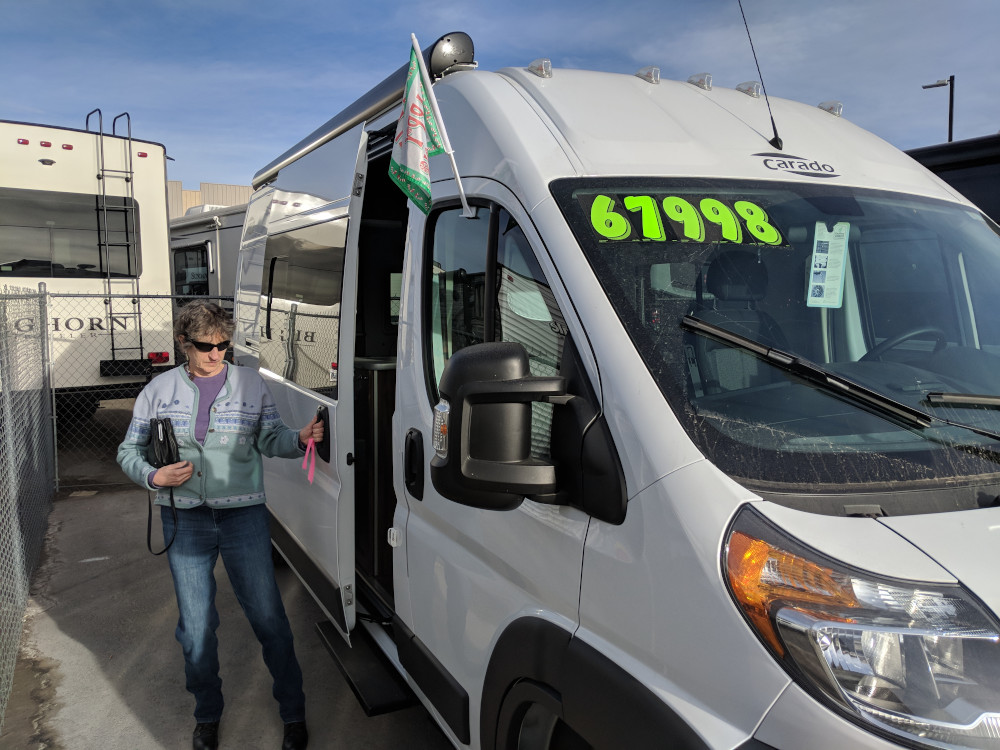
Unlike me, there are a large number of people who actually bought that van. I am still a member of a Facebook group for the van (Carado & Sunlight Owners Group) and I can tell you that the owners of the van are as happy as the owners of vans from other companies. The group is a collection of resourceful individuals who help one another with the quality problems, but those problems don’t seem to diminish their joy of vanning around. The Carado Banff was a good match for these people and it enabled them to venture out.
So the point is— keep your eyes open and be aware of the pros and cons of the vans you are considering, but also keep your mind open to the possibility that a van that didn’t get stellar reviews on a YouTube video might still be a good match for you.
The reverse
The reverse is also true. Just because a couple on YouTube is using van X doesn’t mean it is the right one for you. Maybe it is and maybe it isn’t. You need to do the research. On the other hand, don’t get intimidated by the myriad of van choices. You will quickly start narrowing down your list when considering the following questions:
- How do you intend to use the van?
- Who is going with you?
- What are you bringing along?
- What are your sleeping requirements?
- What is your budget?
As you can see, these questions are common sense and perhaps you have already done this analysis. If so, congratulations. For the rest, let’s get started.
How do you intend to use the van?
Your vision of how you intend to use the van may be fully formed and based on years of experience. Perhaps you’ve owned a travel trailer and now with your children gone you want a smaller, more nimble rig. Or perhaps you are an avid mountain biker and want to get a van as a support vehicle. Or you’ve done dog agility for years and you want a camper van to travel with your dogs to competitions in your region.
But maybe your vision of how you would use a van is more vague. You have a dream of visiting National Parks but the last time you camped was as a child with your family. Maybe you have dreams of an epic road trip or a trip to Alaska or weekend trips to the state parks in your area. Regardless of how solid your vision is, before looking at all the different types of vans it is worthwhile to sketch out both your general vision and a few future trips. For example,
“We are celebrating retirement by spending some time exploring the national parks. We’d like to head to Yosemite and then on to Zion, Bryce, Capital Reef, Arches, Grand Teton and Yellowstone! We are really looking forward to connecting with nature. Do some hiking. We don’t want to be driving long distances everyday. We want to stay at a spot for at least a few days. It would be nice to camp in a remote area but we don’t see ourselves traveling on rugged jeep trails. During the day we might drive somewhere to hike and then come back to our camping spot in the afternoon to relax, read outside, maybe cook by a campfire. We are in our early and mid 60s FYI.” – Ann M.
“My husband and I want to get a van so we can visit family and friends. We are first time RVers. We intend to travel from Northern Virginia (home) to San Francisco CA where our son and daughter in law live and at some other time, travel to Vancouver to visit our other son, and to Florida to visit my parents. Our plan is to either stay in relative’s driveways or at established campgrounds. We want the van to be comfortable–sort of like a hotel room substitute.” – Abigail B.
“I am a software developer and my company allows me to work remotely. My girlfriend is in a similar position. Our plan is to get a van and travel the country while we work. For example, boondock in a nice spot in Oregon for a few days to a week, work 8 to 10 hour days and then relax the rest of the time. I need a workspace and storage for work gear (laptop, tech etc) and then all the fun stuff, kayak, bike, SUP, chairs, table, plus clothes for different climates.” – Brandon O.
Get as specific as you can about the trips you envision. You want to start fleshing out your requirements. For example, Brandon and his girlfriend would benefit from a van with a dedicated lounge/work space, which is something Ann doesn’t necessarily need. For Abigail a lithium system would not be a high priority.
A related question is on a very rainy cold day when you are stuck in the van for the day, what do you see yourself doing?
Watching YouTube camper van reviews is fun but you don’t want to clone some YouTube couple’s vision of van life. What is it that you <insert your name here> want to do? Imagine going out to dinner with a friend and you are conveying your dream with passion and excitement! What would that dream be?
It helps to write it down (as well as writing the answers to the rest of these questions).
Who is going with you?
This is an easy one. Are you going on your van adventures alone? With your partner? children? Pets? If a partner is involved what are their requirements? If you have a dog, how big? Are there times when the dog will stay in the van and you venture out?
What is going with you?
Aside from the gear and clothes you need to live in a van for the span of time you trips last, what other gear are you bringing? Mountain bikes, paddle boards, kayaks, photography equipment? There is limited space in a van and it is helpful to get an understanding of your needs before looking at individual vans.
Sleeping requirements
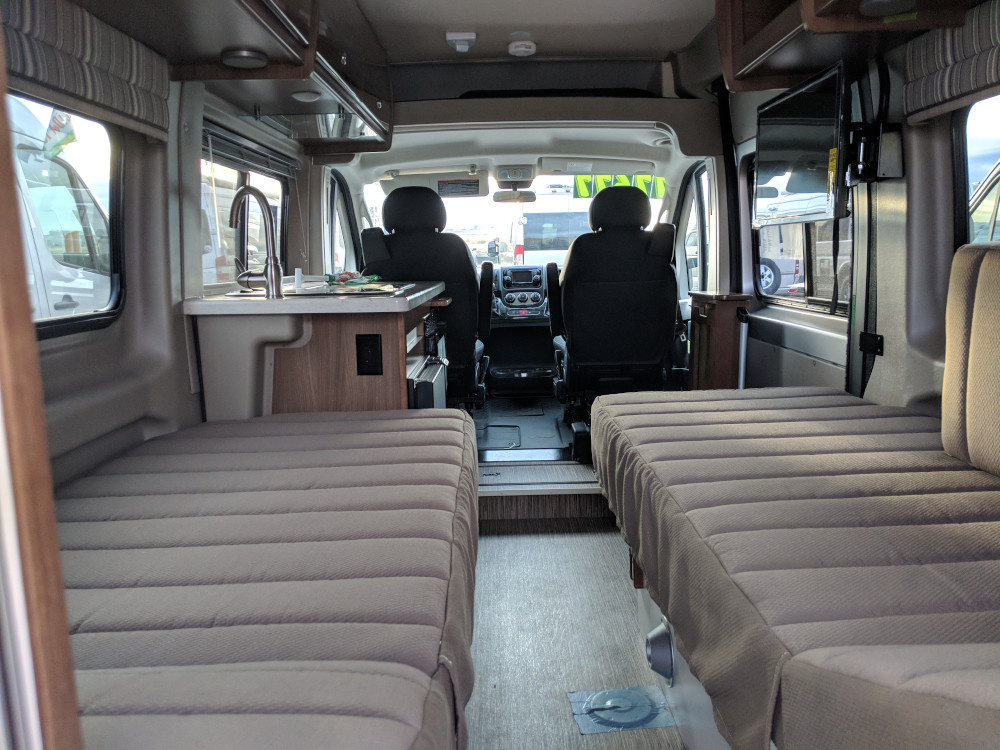
A Class B camper van is primarily a place to sleep and because of this importance, you want the bed to be as comfortable as possible. If the van fails on meeting that requirement, it is not the van for you. So what are your requirements (both the ‘must haves’ and desirables)? Are you 6 foot 1, and need a long bed? Will two single beds work for you or do you need a full size bed or bigger? For example, my spouse and I were looking at the Winnebago Travato 59k which has two twin beds each 30 inches wide and the longest is 80 inches. Fortunately, we have a studio sofa at home that folds out into a 80×30 bed, so I was intimately familiar with how comfortable I was with that size and know that the Travato 59k would be a good match. Don’t skimp on this requirement.
How much can you spend?
You can get a new Class B camper van from a major manufacturer starting in the mid $70,000. If you buy a used commercial van and have it converted by a custom van builder you cost could be even less. (I’ve recently seen a 2018 Ford Transit with a minimal conversion for $26,000) Or you could spend $200,000 or more. How much do you have to spend? What is your desired amount and what is your absolute limit.
The van as a tool.
Starting with the answers to these questions will help you see the van as a tool that will help you do things before getting distracted by the aesthetics and coolness of any van. Granted aesthetics and coolness are important and you can probably make any van work for almost any purpose but it is best to go into this decision with eyes open.
Don’t start with a list of requirements. “I need lithium.”, “I need a Mercedes Sprinter build” That is putting the cart before the horse (or some other more van oriented metaphor). Starting with your answers to the above questions you can build a set of requirements that is tailored to you. Keep in mind that …
Looking at vans before having a clear vision is letting
the Class B manufacturer push a vision on you
For 99.99% of us, it is too late. We already have been watching van YouTube channels, Instagram posts, and review sites and have other people’s opinions of an ideal van stuck in your heads. To balance this, do the suggested work above in outlining and detailing your vision and from that narrative generate a list of requirements.
If you are buying a car things are a bit different. Your requirement list is fairly short. You need some transportation to get to work and back and to go shopping. Maybe it needs to fit your two dogs or your young children. So a Ford F150 or a Toyota Prius would fit your needs equally well and you can get what you think is cool. Vans are different. If your desire is to go on forest service roads to remote sites, and you get a heavy rear wheel drive van that gets stuck on wet grass, you’ve made a decision that will make your life more challenging.
Making a requirements checklist
From all this imagineering work you have done, you can now create a requirements checklist that is tailored to you. Here is the start of one person’s list
- Sleeping/bed requirements: need something 80 inches long, could get by with 78
- Need an indoor storage space for my bikes.
- Need an office space where I could work comfortably on my laptop for a few hours.
- I probably don’t need lithium (I am only running my laptop 2 hrs max per day and don’t have any other big energy needs)
- Don’t really need a microwave or a freezer part of the refrigerator.
- …
With this you have a solid basis for evaluating which van is the best for you. Good luck!
Winnebago Travato 59k
Camp Cooking Gear Guide
Photo courtesy of MIKI Yoshihito. Some rights reserved
Galley Gear
Photo courtesy of thedailyenglishshow.com Some rights reserverd.
“Looking for cookware recommendations for the Travato – any ideas?”
“Hello Group! I am buying an Airstream Interstate. I want to buy dishes and pots and pans before I pick it up. Any ideas?
“We are bringing our new 2018 K home in a few weeks and I’m preparing to outfit the galley. Any suggestions. I’d like to use real dishes, but I’m afraid they’ll rattle around. Very excited.”
If you ordered a van and need to wait weeks to pick it up it is easy to get carried away and order the ultimate set of kitchen items. On the other hand you can resist that urge and once you get the van head over to a big box store to get the basics. Or you can go the middle way, which is what I did, and order the key items that were important to me.
Keep in mind that cooking in a van is nothing special. If you have a cookset and dishes from your car camping days you can use that. A simple frying pan, one sauce pot, and some picnic plates from Walmart will also work. There is nothing fancy that you actually need. That said, there are some kitchen/galley items that repeatedly get recommended in the various vanning forums. I am simply consolidating those recommendations here.
Cookware
Magma Nesting Cookware
By far, the most recommended cookware mentioned in van forum posts is the Magma Nesting Cookware. They sell a number of different models. The 7 piece consists of a 2 qt. sauce pan, a 5 qt. pot and a 10 inch frying pan (plus lids and a handle). The 10 piece adds a 1.5 qt. and a 3 qt. sauce pan. There are sets that are induction ready and some with a non-stick coating. People love the fact that they all stack together in the stock pot making the set easy to store. They also like the quality and durability. Many people with the 10 piece set leave part of the set at home (“ordered the Magna set, but found it had way more pots than I actually needed for two of us”) People with the uncoated sets report that the pans stick when sauteing. “I have a separate ceramic non-stick pan for pancakes.”
Keep in mind they are expensive (typically, $150-250)!
Magma Nesting Stainless Steel Colander
A nice addition to the set is the Magma Nesting Stainless Steel Colander which people use both as a colander and as a steamer. It can nest inside the cookware set but it raises the lid increasing the overall height and preventing the set from being stored in some overhead van bins
Stansport 7 Piece Stainless Steel Cookware Set
This nesting set is a fraction of the cost of the Magma (around $55). In contrast to the Magma 7 piece which has 2 pots and one frying pan, the Stansport 7 piece features 4 pots: 1 qt. 2 qt., 3 qt. and 4 qt. and a 10 inch frying pan. This set is stainless steel and has a triple ply bottom, similar in quality to my home pots and pans. For some reason this set is not mentioned much on van forums. Common complaints are that it only has one common lid for the 1, 2, and 3 qt pans and only has one handle shared among the pots and frying pan. This is the set I own
Lodge Cast Iron Cookware
As nature photographer and YouTuber Mandy Lea says “Number one in any camping situation has got to be cast iron pans [and] the number one brand in cast iron pans … is Lodge.” Cast iron is equally at home, cooking in your van or outside on a Coleman stove or campfire. In fact, there is no better choice for cooking on a campfire than with cast iron. The frying pans in the Magma and Stansports sets mentioned above are great, but when you need more space, for example, for a stir fry, a cast iron skillet is the way to go. I have the Lodge Combo Cooker, which is a 3.2 quart deep skillet and dutch oven. It has plenty of room for making stir fries for two. Others prefer having a traditional Lodge skillet and an adorable yet functional small Lodge Dutch Oven. Don’t forget the extremely useful Lodge Pan Scrapers. If you never cook outdoors, you might not find having cast iron cookware useful.
Carbon Steel Skillet
Like the cast iron concept but don’t like the weight? You might consider its lighter brother, carbon steel. Carbon steel is thinner than cast so it doesn’t retain heat as well, but the benefit of that is that it adjusts to temperature changes faster. Carbon Steel cookware tends to be more expensive than cast iron. That said, I’ve had a cheap $20 carbon steel wok for years and it has been my go to pan for stir fries, Thai fried rice, and green curry. I love the thing. The wok is small by wok standards — 12 inches by 3 inches high. Still it is a bit too bulky for me to carry in the van. My solution is an 11 inch carbon steel skillet. I prefer the BK Cookware Black Carbon Steel Skillet, which I like because it has high sides (easier to cook stir fries in). Others prefer the Lodge 12 Inch Seasoned Carbon Steel Skillet (better for searing meats). The Lodge has lower sides, which might be fine for your style of cooking. It has a rough finish, reminiscent of cast iron and unlike my wok. Carbon Steel is definitely not as popular as cast iron among the Class B camper van crowd, so you will be in the forefront of the carbon steel crowd.
Dinnerware
There are wildly different opinions about dinnerware in Class B vans. And there are a lot of trade-offs. Some opt for paper plates to conserve cleanup water, but that is not an environmentally friendly choice. My preference is with enamelware but here are the most popular options mentioned in van forums.
Nordic Ware
A popular choice among van owners is to use reusable plastic plates such as those from Nordic Ware. The benefit of plastic is that it is unbreakable and they don’t rattle when traveling. However, there is some debate as to the health safety of any plastic so some avoid it.
Melamine
In a YouTube video, photographer and RVer Mandy Lea, a person I mentioned in the cast iron section above (and who I think is absolutely fantastic), recommends Melamine dinnerware and, in particular this set, saying that melamine is durable and virtually unbreakable. Both of these are true and melamine is an extremely popular choice for any RVer including those in a van. If melamine makes you happy, go with it, but here are my concerns. Melamine dishware is made from a resin of melamine formaldehyde and. When you eat food from a melamine plate, some amount of the chemical melamine migrates from the plate into your body. While the E.U. is considering banning melamine dishware, it is considered safe by the United States FDA with this caveat: “Foods and drinks should not be heated on melamine-based dinnerware in microwave ovens.”[FDA] This is because the amount of melamine that migrates from a dish to a person increases as heat increases and as the food becomes more acidic. In an article published in The Journal of the American Medical Association Internal Medicine, Dr. Chia-Fang Wu found that the dinnerware released high quantities of melamine into people who were using melamine bowls to eat hot soup [2013]. Melamine is not a benign chemical. An article in the journal Science describes a case where 53,000 children were hospitalized due to melamine tainted infant formula powder [2008] and there are adult cancer risks according to the International Agency for the Research on Cancer [2017][WHO]. In addition, the manufacturing of melamine is bad for the environment [2010]. In summary, why risk it when there are much safer options such as enamelware described below and silicone dishware for microwaving. I apologize for this long rant.
Corelle
Another very popular option is Corelle, which from a health safety perspective is significantly better than plastic. People like Corelle because they are “real dishes”, are break resistant, thin, and lightweight. Plus you can use them in a microwave. Although they rarely break, when they do it is a mess “Corelle dishes were a disaster in our RV. They are made of glass, not ceramic or porcelain. Every time we broke a dish we would find small, very fine shards of glass throughout the van for weeks after. We broke most of them. On one notable occassion [sic] the cupboard door sprung open in hard cornering, the dishes hit the floor and all but one shattered.” – Murray, Lorri, and Clara. Others have echoed this experience although most say they are unbreakable.
Enamelware
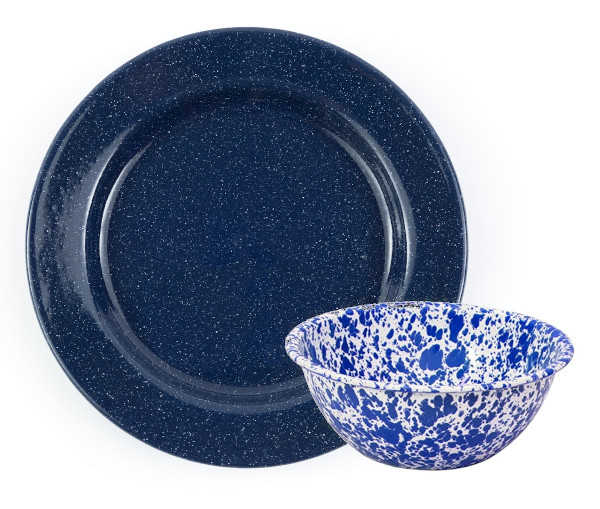
Crow Canyon Dinner Plate – solid white with blue rim
Crow Canyon Salad Bowls – blue marble
The Crow Canyon website featuring more designs including traditional speckled.
Since the 1910s, enamelware has been associated with recreational vehicle camping. (For a fascinating glimpse of early RV days see George Lorando Lawson’s “An Automotible Praire Schooner” Country Life June 1908). From the traditional speckled pattern to more modern designs, enamelware is a great choice today. Healthwise, it is safe to use and it is unbreakable. Enameled dinnerware is thin and attractive. The drawback is you cannot use them in a microwave. Also since metal transfers heat better than other material, an enamelware bowl of hot soup will be, well, hot. You can buy a lower quality enamelware 12 piece set for under $30 online or at a big box store, or, expensive elegant enamelware from Falcon, one of the original manufacturers. The best from a price-to-quality perspective, and the one I recommend is Crow Canyon.
